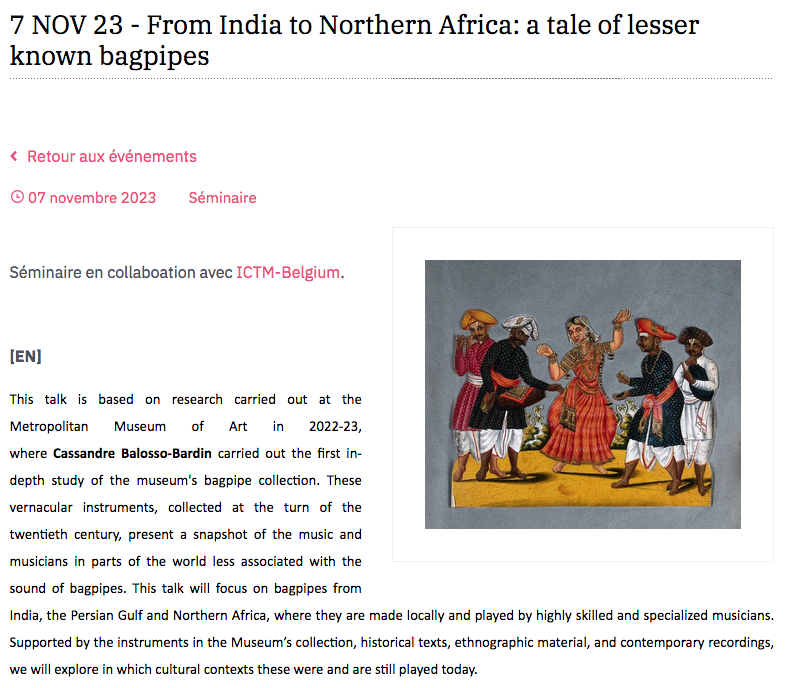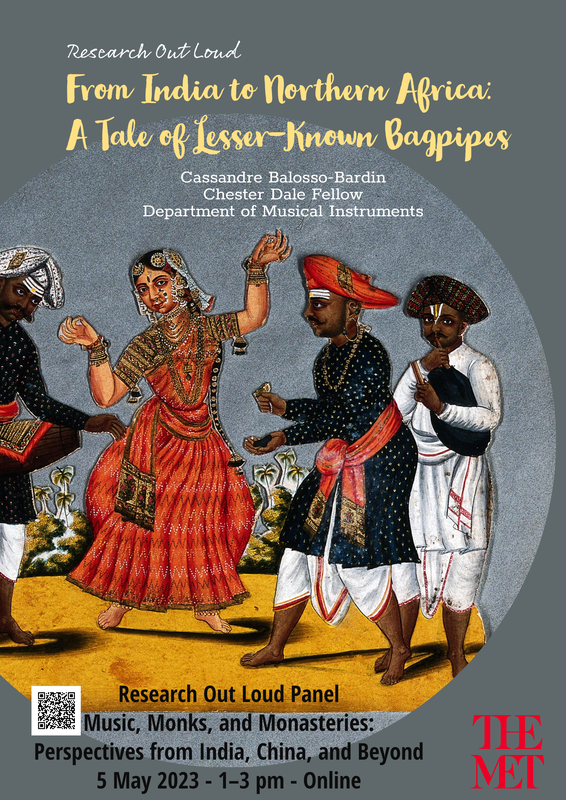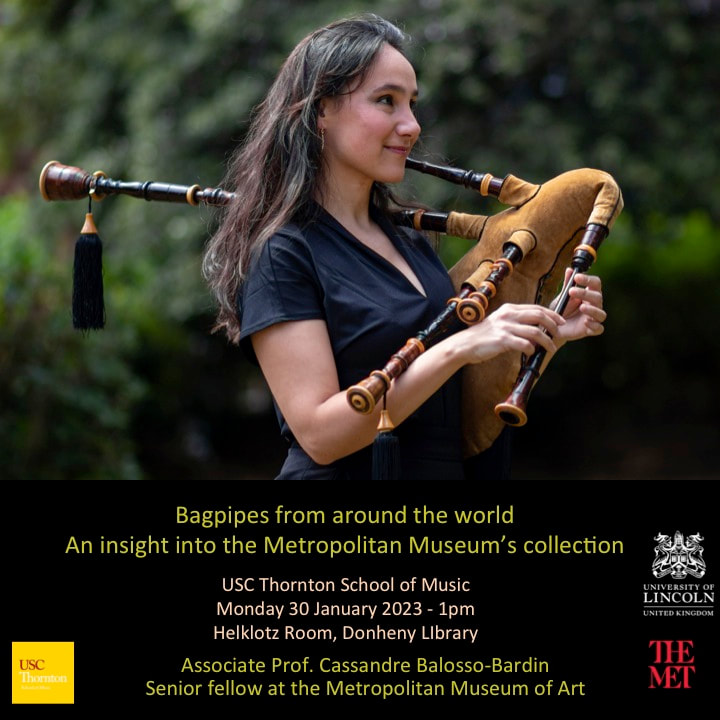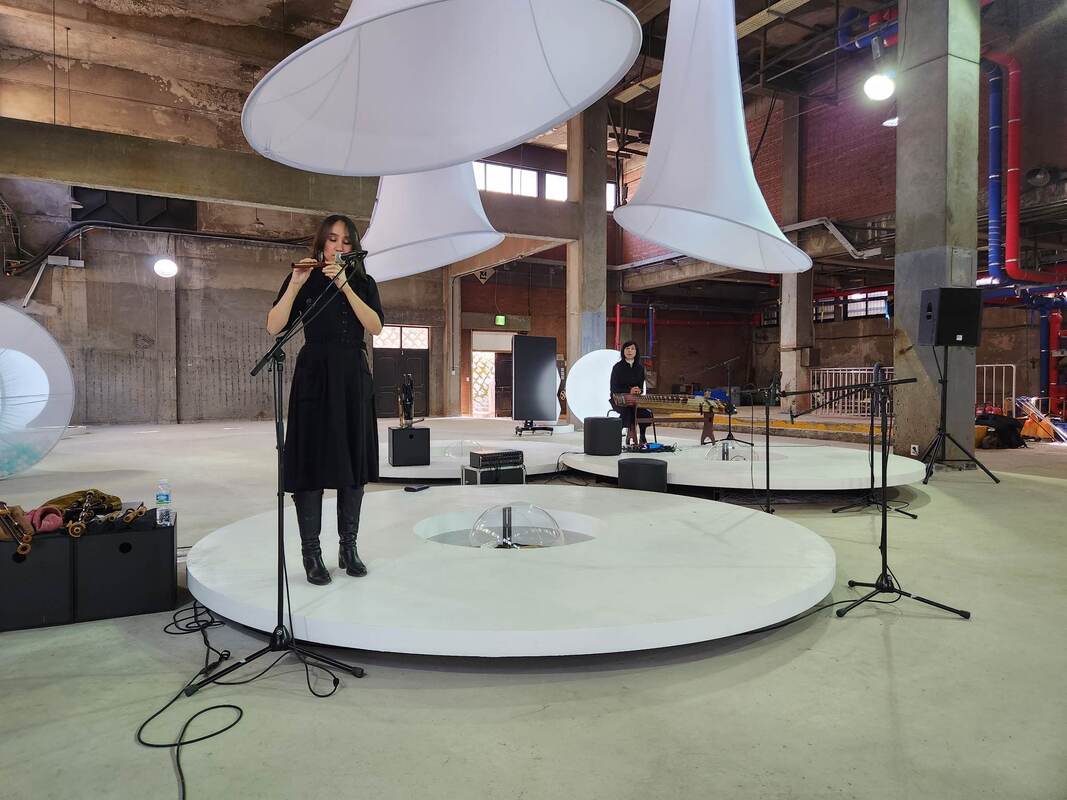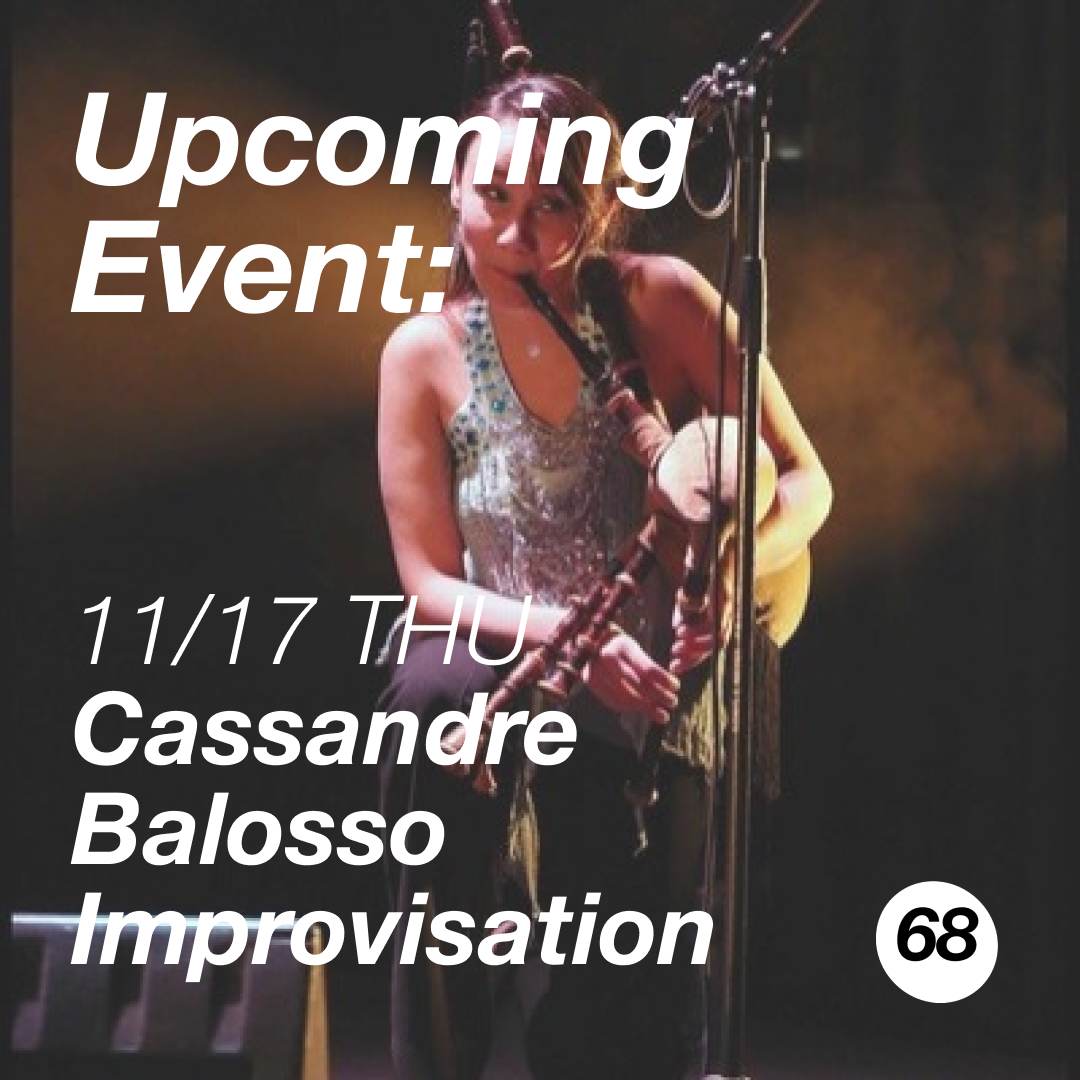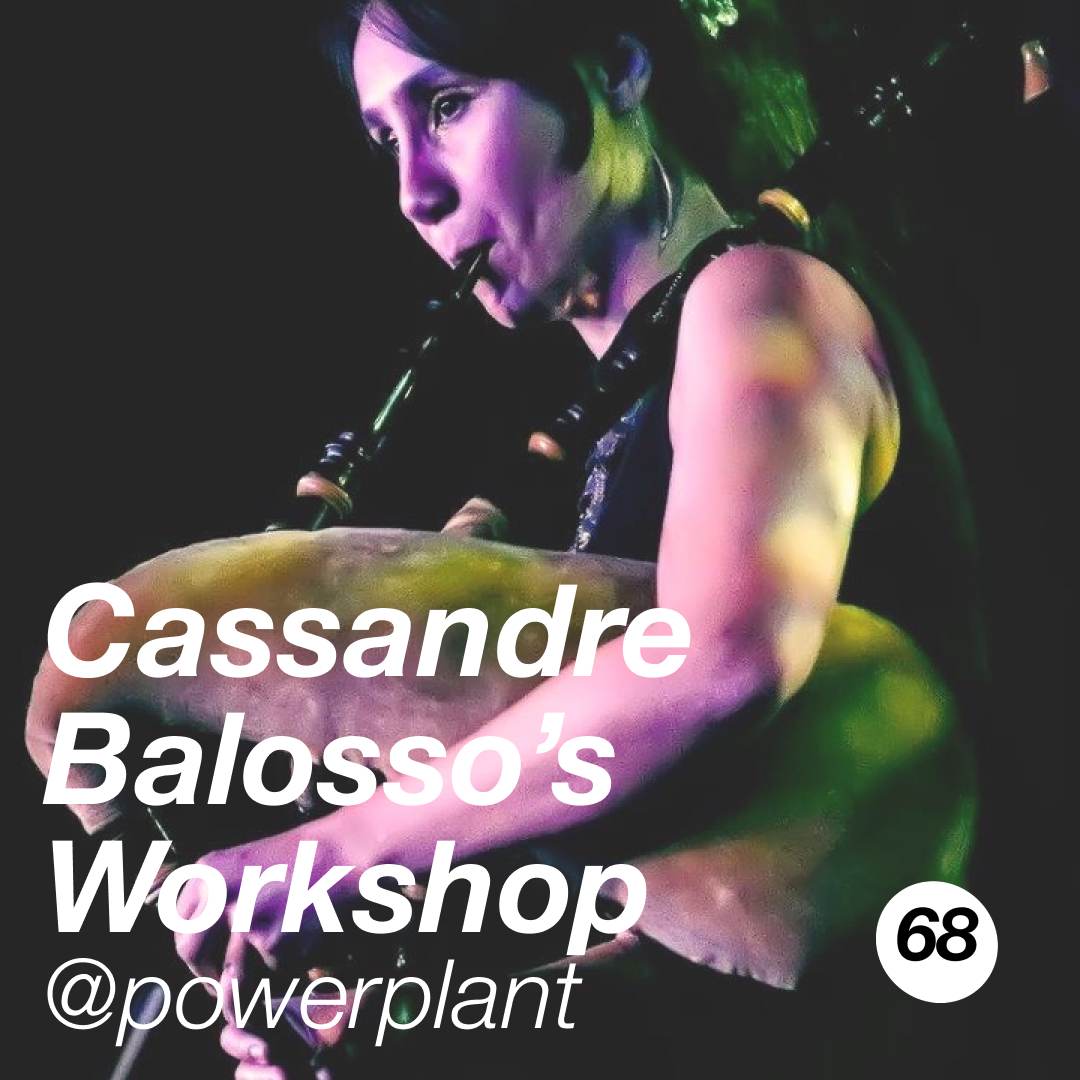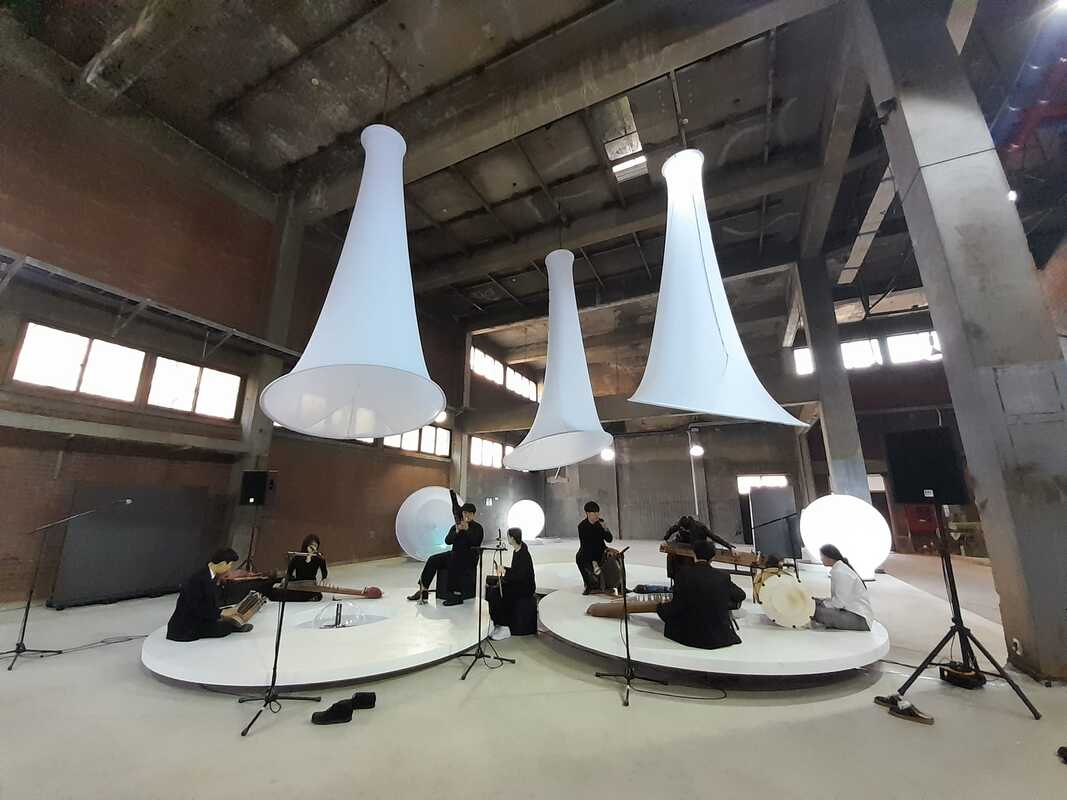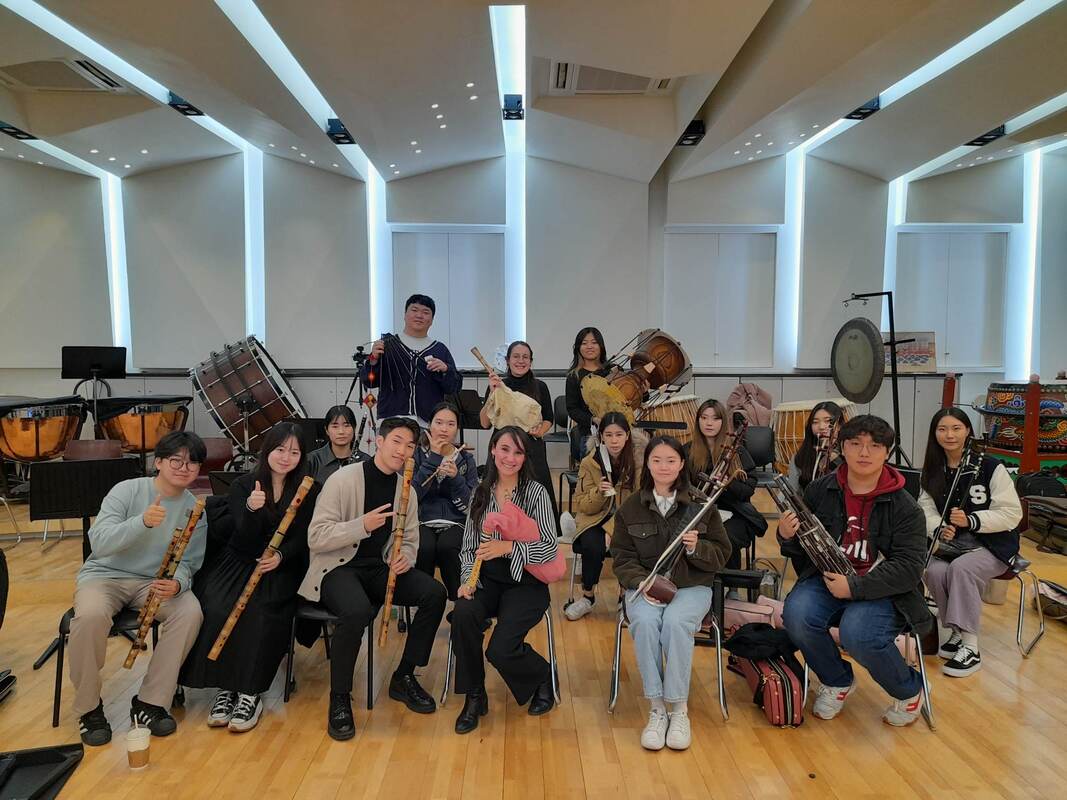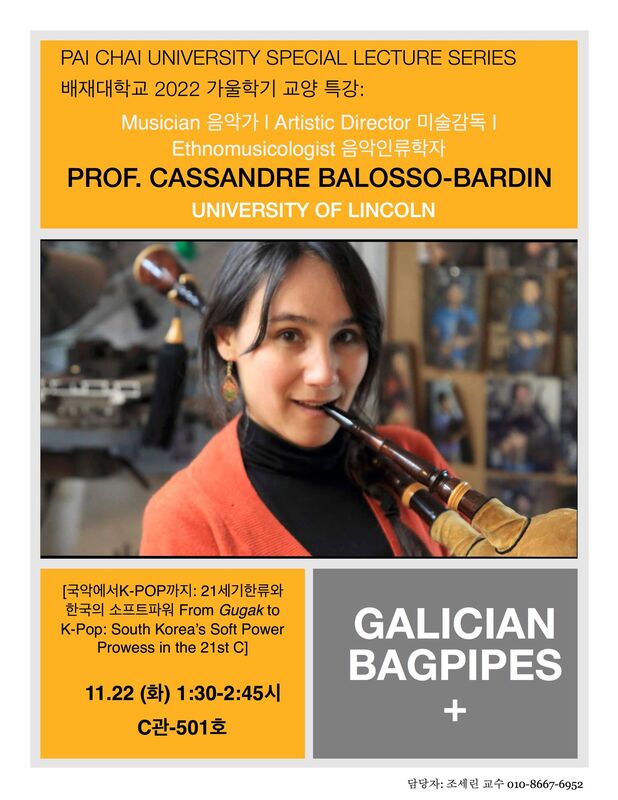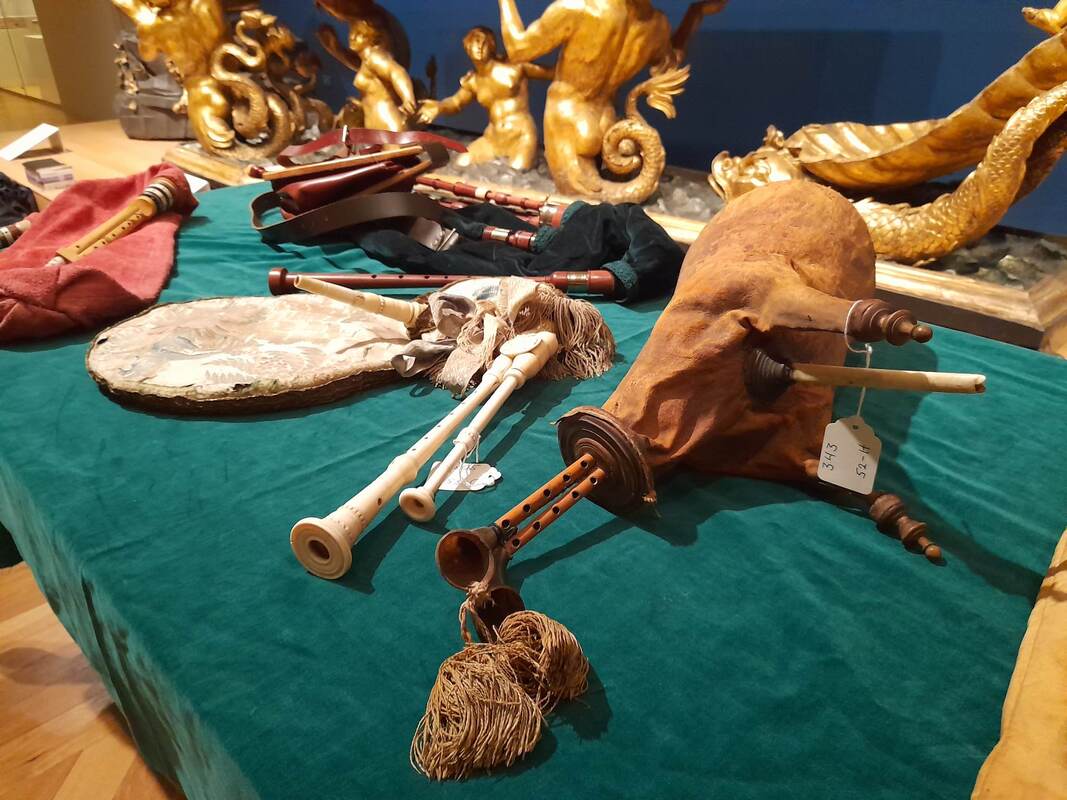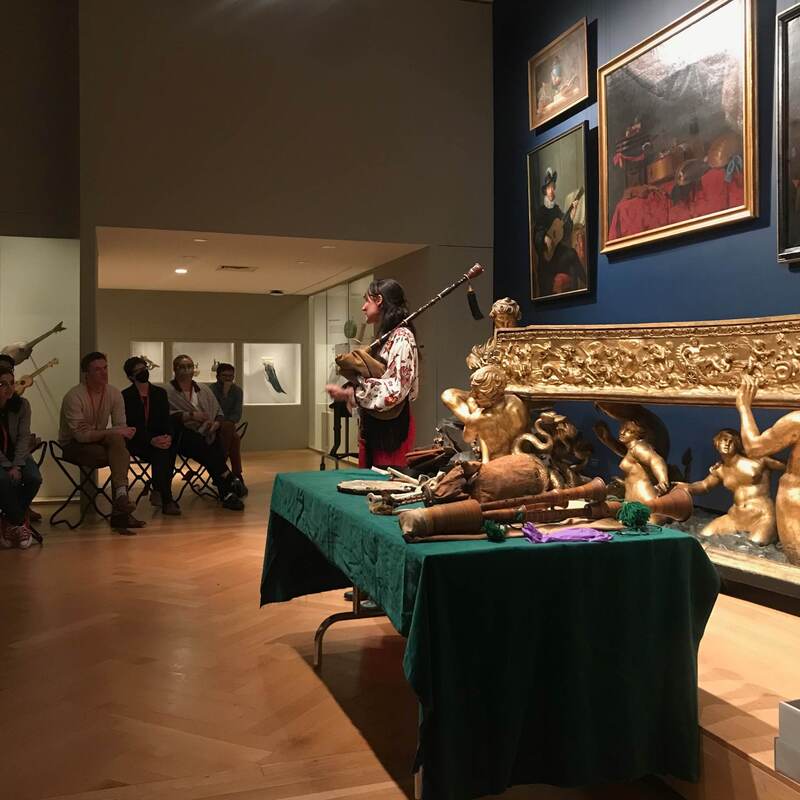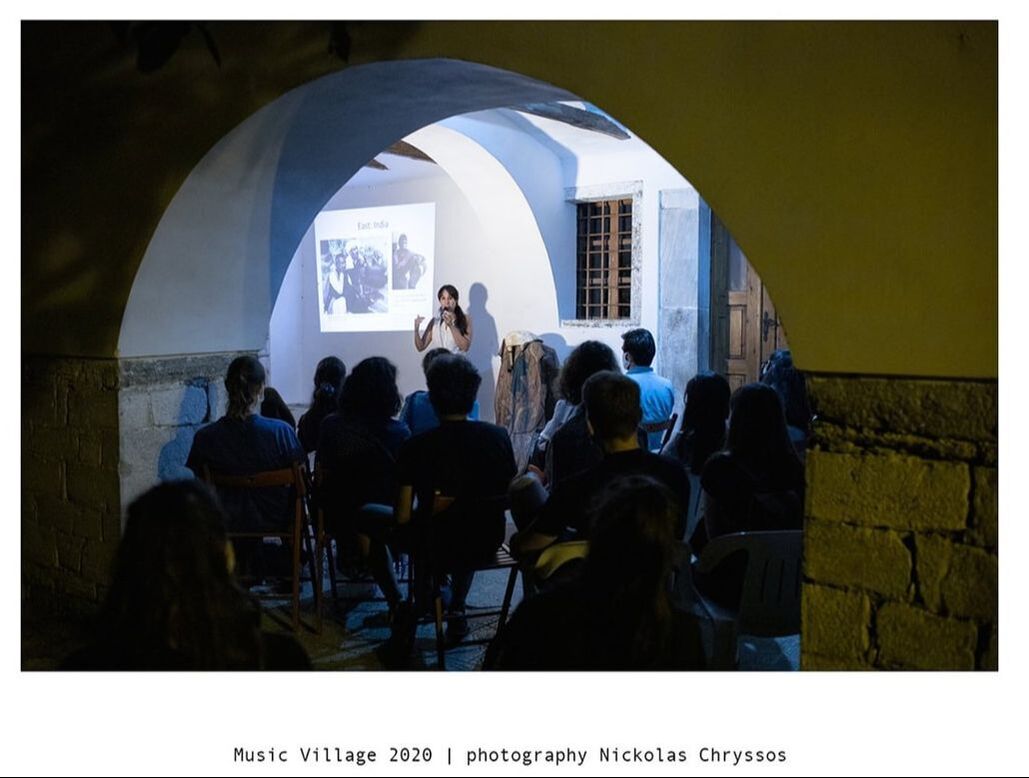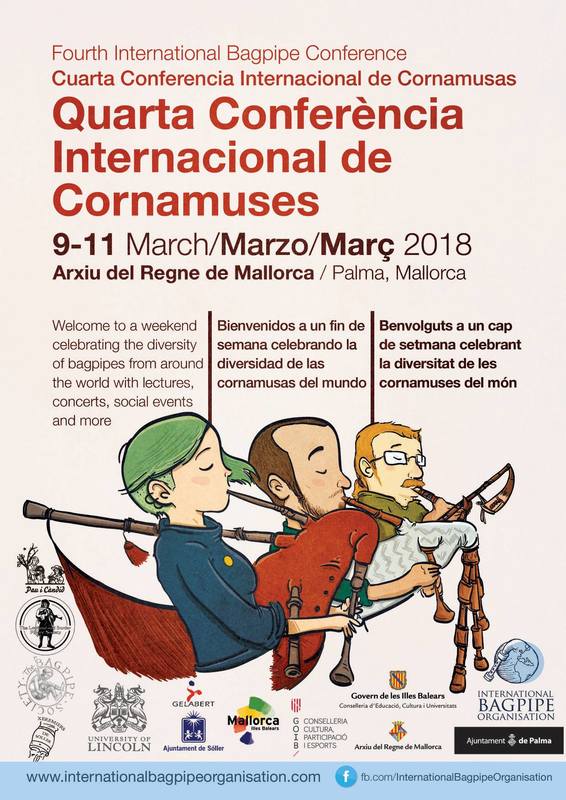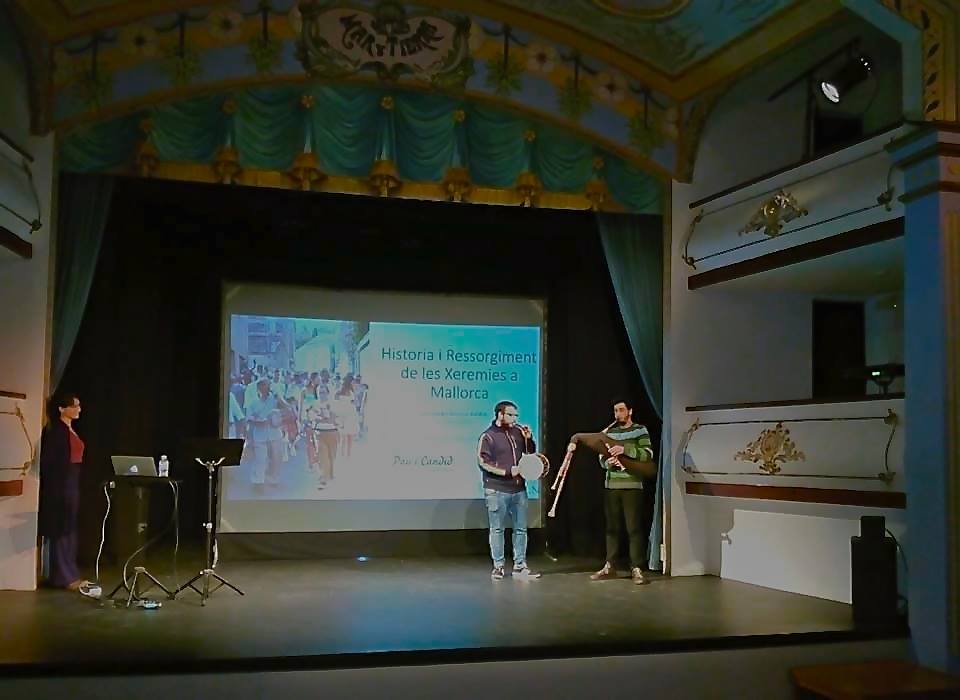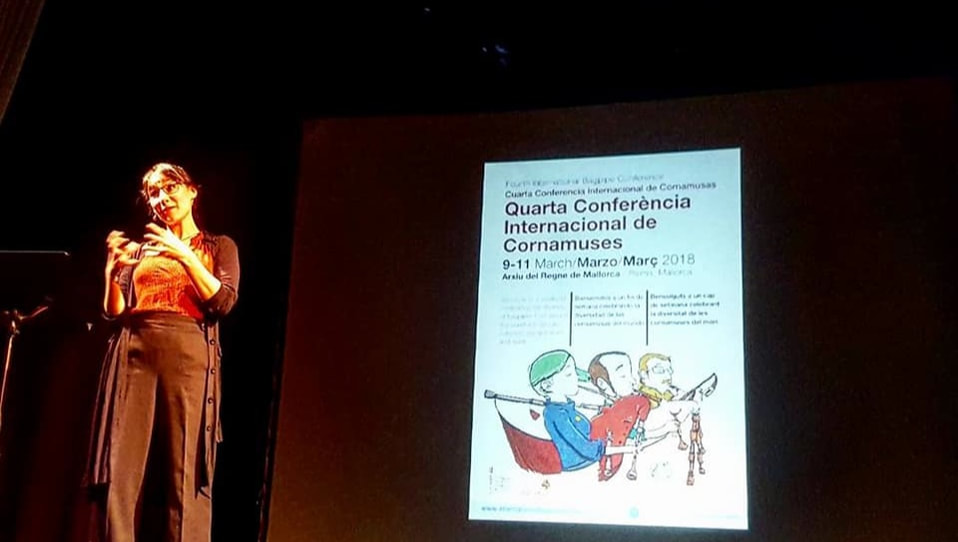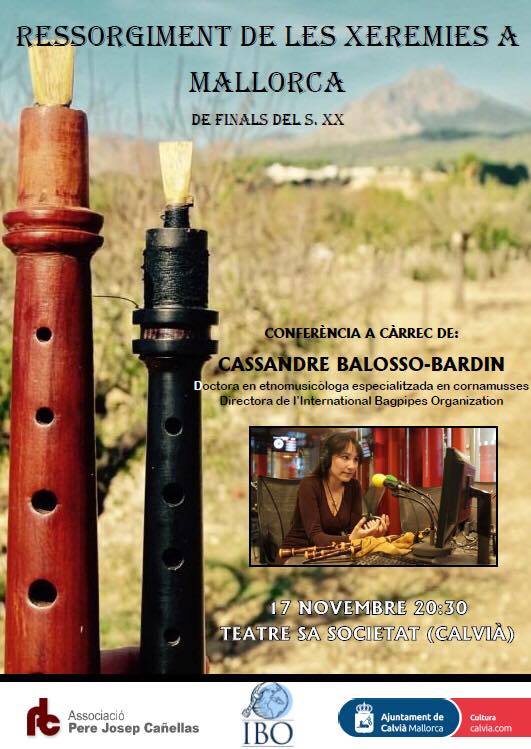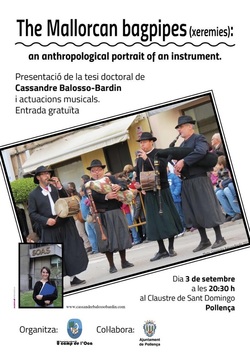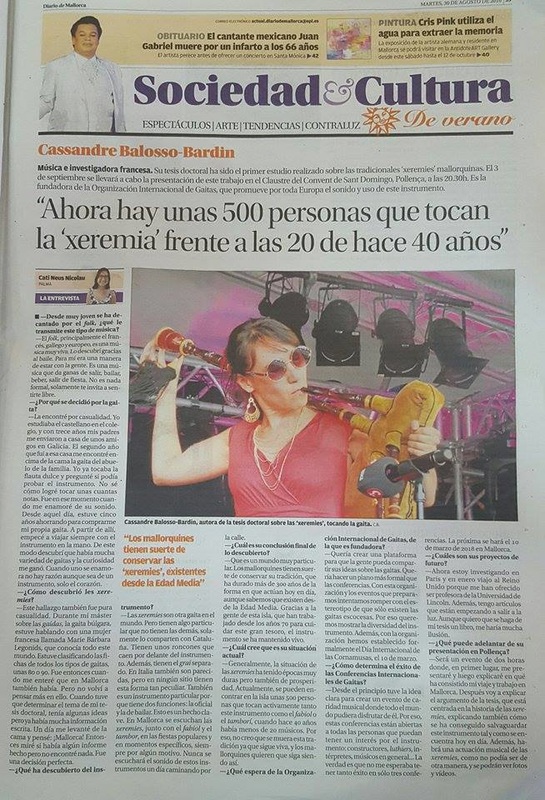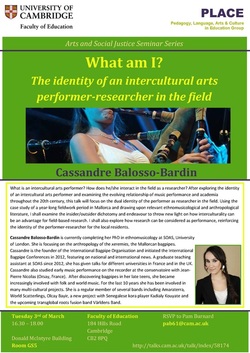TALKS AND CONFERENCES
Upcoming Presentations
8-10 March 2024
Conference: Seventh International Bagpipe Conference
Academy of Music, Dance, and Fine Arts, Plovdiv, Bulgaria
Presentation title: The Metropolitan Museum’s Bagpipe Collection: Aesthetics, Materials, and Symbolism
Abstract
The Metropolitan Museum hosts a collection of 52 bagpipes from around the world. Collected mainly by Mary Elizabeth Brown at the turn of the 19th century, these span a large geographical area, from India to Ireland, Russia to Libya. The instruments are made from a wide range of materials such as hide, wood, metal and reed, that are not only functional but also highly aestheticized and imbued with symbolical meaning. Consider the finely carved goat head with miniature ivory teeth on a 19th century Central French musette, a bejeweled square cross and tiny metallic bird ornaments on an old Russian volynka, small human features that anthropomorphize the Croatian diple, and grotesque dolphin heads on the stock of a French 19th century fantasy bagpipe - reminiscent of the coat of arms of pre-revolution French princes -, as well as the use of tassels, satin, ribbons, ivory, engravings, lead incrustations and even decalcomania on many other instruments.
This presentation will open with an introduction to the collection, providing a brief summary of how the instruments came to the collection. I will then examine specific examples of how instruments merge functional materials (such as animal hide, textile, horns, and rope) and shapes (such as stocks, chanters and drones) with aesthetics and symbolism. This includes forays into the realms of the animal kingdom, religion, superstition and exoticism as well as into the social mobility and musical function of some of these instruments. This paper is the outcome of a Chester Dale Fellowship at the Metropolitan Museum.
Conference: Seventh International Bagpipe Conference
Academy of Music, Dance, and Fine Arts, Plovdiv, Bulgaria
Presentation title: The Metropolitan Museum’s Bagpipe Collection: Aesthetics, Materials, and Symbolism
Abstract
The Metropolitan Museum hosts a collection of 52 bagpipes from around the world. Collected mainly by Mary Elizabeth Brown at the turn of the 19th century, these span a large geographical area, from India to Ireland, Russia to Libya. The instruments are made from a wide range of materials such as hide, wood, metal and reed, that are not only functional but also highly aestheticized and imbued with symbolical meaning. Consider the finely carved goat head with miniature ivory teeth on a 19th century Central French musette, a bejeweled square cross and tiny metallic bird ornaments on an old Russian volynka, small human features that anthropomorphize the Croatian diple, and grotesque dolphin heads on the stock of a French 19th century fantasy bagpipe - reminiscent of the coat of arms of pre-revolution French princes -, as well as the use of tassels, satin, ribbons, ivory, engravings, lead incrustations and even decalcomania on many other instruments.
This presentation will open with an introduction to the collection, providing a brief summary of how the instruments came to the collection. I will then examine specific examples of how instruments merge functional materials (such as animal hide, textile, horns, and rope) and shapes (such as stocks, chanters and drones) with aesthetics and symbolism. This includes forays into the realms of the animal kingdom, religion, superstition and exoticism as well as into the social mobility and musical function of some of these instruments. This paper is the outcome of a Chester Dale Fellowship at the Metropolitan Museum.
27-30 June 2024
Conference: American Musical Instrument Society, Annual Conference
Musical Instrument Museum, Phoenix, USA
Presentation title: The sruti upanga: the drone of the devadasi
Abstract
The sruti upanga is a mysterious instrument. It is a simple bagpipe, composed of an animal bag, an insufflation pipe and a pipe with six or seven holes. Mostly extinct today, especially in Tamil Nadur (Southern India) where it was historically most played, it is ubiquitous in iconography from the late 18th century until the early 20th century. There, amongst other musicians and dancers, one can regularly spot a man playing this instrument. The sruti upanga was one of the instruments played by male musicians to accompany the devadasi, hereditary female devotional dancers and singers. Despite the instrument’s regular appearance in a wide variety of paintings and its presence in some photographic material, only very few examples of the instrument exist in musical collections. The Metropolitan Museum in New York (USA) and the Pitt Rivers Museum in Oxford (UK) hold two well-preserved examples. Other than its mention in a handful of historical sources, this instrument is absent from organological and musicological literature.
This paper will shed light on what seems to be a mostly extinct instrument. Led by archival research, organological observations, and the analysis of the only known video of the instrument, I will describe the instrument and its musical role. I will define the social role of the musicians and performers around this instrument, and put forward a theory as to its extinction in the 1930s and 1940s. Based on the analysis of musical drones in carnatic music as well as the playing technique of the instrument, I will suggest what the instrument’s musical influence might have been on Southern Indian carnatic music.
Conference: American Musical Instrument Society, Annual Conference
Musical Instrument Museum, Phoenix, USA
Presentation title: The sruti upanga: the drone of the devadasi
Abstract
The sruti upanga is a mysterious instrument. It is a simple bagpipe, composed of an animal bag, an insufflation pipe and a pipe with six or seven holes. Mostly extinct today, especially in Tamil Nadur (Southern India) where it was historically most played, it is ubiquitous in iconography from the late 18th century until the early 20th century. There, amongst other musicians and dancers, one can regularly spot a man playing this instrument. The sruti upanga was one of the instruments played by male musicians to accompany the devadasi, hereditary female devotional dancers and singers. Despite the instrument’s regular appearance in a wide variety of paintings and its presence in some photographic material, only very few examples of the instrument exist in musical collections. The Metropolitan Museum in New York (USA) and the Pitt Rivers Museum in Oxford (UK) hold two well-preserved examples. Other than its mention in a handful of historical sources, this instrument is absent from organological and musicological literature.
This paper will shed light on what seems to be a mostly extinct instrument. Led by archival research, organological observations, and the analysis of the only known video of the instrument, I will describe the instrument and its musical role. I will define the social role of the musicians and performers around this instrument, and put forward a theory as to its extinction in the 1930s and 1940s. Based on the analysis of musical drones in carnatic music as well as the playing technique of the instrument, I will suggest what the instrument’s musical influence might have been on Southern Indian carnatic music.
27-30 June 2024
Conference: The Materiality and Meaning of Musical Instruments, Galpin Society
Oxford University, Bates Museum
Presentation title: From Cairo to Marrakesh: Nineteenth century historical accounts of African bagpipes
Abstract
At last, carts, baggage and escort, with the women and children, surrounded by a singing, yelling crowd of excited friends and relatives, with many drums and bagpipes, and all the rag, tag, and bobtail of Tripoli, rolled out through the narrow roads to the first camping-place (Vischer, 1910:22)
In 1910, Hanns Vischer (1876-1945) published his account of a caravan journey Across the Sahara desert from Tripoli to Bornu. Vischer was an education adviser to the government of the Northern Nigeria Protectorate for the British colonial service. His knowledge of Arabic, Hausa, Fulani and Kanuri meant that his account of a journey from Tripli to Bornu, following historical slave trade routes, was full of reported conversations and anthropological observations, bringing to life the people he travelled with. In this volume, Vischer mentions the bagpipes regularly, making it one of the most vivid and socially accurate accounts of this instrument historically.
This presentation gives an overview of travel accounts from the nineteenth and early twentieth centuries, providing new insights into the bagpipes of Northern Africa. From Egypt to Morocco, these sources supplement the tangible examples that are found in British and American collections, giving insight into local proactices, some of which seem to have disappeared. They also provide new information as to the reach of these instruments, who played them, and in which social situations. While contextualisting the accounts in their colonial and imperialist contexts, I offer here a first attempt at writing a history of the mizwid and zukra through historical texts written in French, Italian, and English.
Conference: The Materiality and Meaning of Musical Instruments, Galpin Society
Oxford University, Bates Museum
Presentation title: From Cairo to Marrakesh: Nineteenth century historical accounts of African bagpipes
Abstract
At last, carts, baggage and escort, with the women and children, surrounded by a singing, yelling crowd of excited friends and relatives, with many drums and bagpipes, and all the rag, tag, and bobtail of Tripoli, rolled out through the narrow roads to the first camping-place (Vischer, 1910:22)
In 1910, Hanns Vischer (1876-1945) published his account of a caravan journey Across the Sahara desert from Tripoli to Bornu. Vischer was an education adviser to the government of the Northern Nigeria Protectorate for the British colonial service. His knowledge of Arabic, Hausa, Fulani and Kanuri meant that his account of a journey from Tripli to Bornu, following historical slave trade routes, was full of reported conversations and anthropological observations, bringing to life the people he travelled with. In this volume, Vischer mentions the bagpipes regularly, making it one of the most vivid and socially accurate accounts of this instrument historically.
This presentation gives an overview of travel accounts from the nineteenth and early twentieth centuries, providing new insights into the bagpipes of Northern Africa. From Egypt to Morocco, these sources supplement the tangible examples that are found in British and American collections, giving insight into local proactices, some of which seem to have disappeared. They also provide new information as to the reach of these instruments, who played them, and in which social situations. While contextualisting the accounts in their colonial and imperialist contexts, I offer here a first attempt at writing a history of the mizwid and zukra through historical texts written in French, Italian, and English.
5-7 July 2024
Conference: Mahillon and his time
Musée des Instruments de Musique, Brussels, Belgium
Presentation title: Mary Elizabeth Brown’s Global Network: A case study of the Metropolitan Museum’s bagpipe collection
Abstract
Mary Elizabeth Brown was an avid musical instrument collector. After donating her first 270 musical instruments to the Metropolitan Museum of Art in 1889, effectively consolidating the place of musical instruments within the institution, and assigning herself as the curator of the collection, she worked with contacts across the world to grow the collection.
Brown had a strong interest in bagpipes if one is to judge by the museum’s healthy collection. By 1908, the musical instrument department counted 38 bagpipes from across the world. Brown frequently called upon her extensive network to seek out specific instruments. Her pursuit of a French bagpipe, for example, was strong enough for her to write to Victor-Charles Mahillon, the curator of the musical instruments collection at Brussels’ Royal Music Conservatoire. On 30th May 1894, she asked: ‘Would it be possible to get a Musette (French bagpipe) for I have none in my collection?’ (Letter Brown to Mahillon, MetMuseum archives). Mahillon was already a close acquaitance, and they had met in person when Brown visited Brussels not long before. Mahillon became a key ally in building the collection: he shipped over new instruments, but also identified desirable pieces and put her in contact with other European collectors and sellers.
One of the strengths of Mary Elizabeth Brown’s collection is that she accepted all sorts of music-making items. She collected instruments that her contemporaries barely considered a musical object. As such, some objects in the collection are rare witnesses of music that has since disappeared, or that has drastically changed over the last 120 years. This is the case of the Indian sruti upanga bagpipe, which is mostly extinct today. In other instances, the Met holds some of the oldest examples of instruments still played today, such as the Met Museum’s Maltese Zaqq, which is a rare historical example of the instrument (Borg Cardona 2020).
In this paper, I will focus on how Mary Elizabth Brown collected the widely different thirty-eight bagpipes that are now held in New York. Coming from places such as India, Egypt, France, Greece, Turkey, and the UK, she relied on friends, commercial partners, and government officials to scout, purchase, and send them to New York. By examining her correspondence and the material evidence at hand, I will contextualise Brown’s collecting practice and trace the international routes that brought these instruments to one of the most prominent insrument collections of the world.
Conference: Mahillon and his time
Musée des Instruments de Musique, Brussels, Belgium
Presentation title: Mary Elizabeth Brown’s Global Network: A case study of the Metropolitan Museum’s bagpipe collection
Abstract
Mary Elizabeth Brown was an avid musical instrument collector. After donating her first 270 musical instruments to the Metropolitan Museum of Art in 1889, effectively consolidating the place of musical instruments within the institution, and assigning herself as the curator of the collection, she worked with contacts across the world to grow the collection.
Brown had a strong interest in bagpipes if one is to judge by the museum’s healthy collection. By 1908, the musical instrument department counted 38 bagpipes from across the world. Brown frequently called upon her extensive network to seek out specific instruments. Her pursuit of a French bagpipe, for example, was strong enough for her to write to Victor-Charles Mahillon, the curator of the musical instruments collection at Brussels’ Royal Music Conservatoire. On 30th May 1894, she asked: ‘Would it be possible to get a Musette (French bagpipe) for I have none in my collection?’ (Letter Brown to Mahillon, MetMuseum archives). Mahillon was already a close acquaitance, and they had met in person when Brown visited Brussels not long before. Mahillon became a key ally in building the collection: he shipped over new instruments, but also identified desirable pieces and put her in contact with other European collectors and sellers.
One of the strengths of Mary Elizabeth Brown’s collection is that she accepted all sorts of music-making items. She collected instruments that her contemporaries barely considered a musical object. As such, some objects in the collection are rare witnesses of music that has since disappeared, or that has drastically changed over the last 120 years. This is the case of the Indian sruti upanga bagpipe, which is mostly extinct today. In other instances, the Met holds some of the oldest examples of instruments still played today, such as the Met Museum’s Maltese Zaqq, which is a rare historical example of the instrument (Borg Cardona 2020).
In this paper, I will focus on how Mary Elizabth Brown collected the widely different thirty-eight bagpipes that are now held in New York. Coming from places such as India, Egypt, France, Greece, Turkey, and the UK, she relied on friends, commercial partners, and government officials to scout, purchase, and send them to New York. By examining her correspondence and the material evidence at hand, I will contextualise Brown’s collecting practice and trace the international routes that brought these instruments to one of the most prominent insrument collections of the world.
Past Events
|
28 November 2023 (Première)
Don't Mind If I Don't - Pilot Episode Blurb: In this inaugural episode of Don't Mind If I Don't, actor/comedian Aaron Gold tries to see the merits of bagpipes. Will his horizons be expanded? Or if someone wants a cacophony of honking, should they just do what normal people do and tape a bunch of geese together? He interviews bagpipe expert Dr Cassandre Balosso-Bardin and piper John Henderson to find out more... Hosts: Aaron Gold and Christine Stoddard Director: Tom Dunn Special Guests: Cassandre Balbar, International Bagpipe Organization John Henderson, NYU & King's County Pipes & Drums Band Director of Photography/Editor: Jacob Maximilian Baron Line Producer: Bridget Dennin Production Assistant: Betsy Ramazzini Filmed on location at Manhattan Neighborhood Network (MNN) in New York City. |
|
|
7 November 2023
Université Libre de Bruxelles, Seminar Series Presentation title: From India to Nothern Africa: a tale of lesser-known bagpipes Abstract This talk is based on research carried out at the Metropolitan Museum of Art in 2022-23, where Cassandre Balosso-Bardin carried out the first in-depth study of the museum's bagpipe collection. These vernacular instruments, collected at the turn of the twentieth century, present a snapshot of the music and musicians in parts of the world less associated with the sound of bagpipes. This talk will focus on bagpipes from India, the Persian Gulf and Northern Africa, where they are made locally and played by highly skilled and specialized musicians. Supported by the instruments in the Museum’s collection, historical texts, ethnographic material, and contemporary recordings, we will explore in which cultural contexts these were and are still played today. |
31 May-3 June 2023
Conference: American Musical Instrument Society's Annual Meeting
Rudi E. Scheidt School of Music at the University of Memphis, USA
Presentation title: The Metropolitan Museum’s Bagpipe Collection: Aesthetics, Materials, and Symbolism
Abstract
The Metropolitan Museum hosts a collection of 53 bagpipes from around the world. Collected mainly by Mary Elizabeth Brown at the turn of the 19th century, these span a large geographical area, from India to Ireland, Russia to Libya. The instruments are made from a wide range of materials such as hide, wood, metal and reed, that are not only functional but also highly aestheticized and imbued with symbolical meaning. Consider the finely carved goat head with miniature ivory teeth on a 19th century Central French musette, a bejeweled square cross and tiny metallic bird ornaments on an old Russian volynka, small human features that anthropomorphize the Croatian diple, and grotesque dolphin heads on the stock of a French 19th century fantasy bagpipe - reminiscent of the coat of arms of pre-revolution French princes -, as well as the use of tassels, satin, ribbons, ivory, engravings, lead incrustations and even decalcomania on many other instruments.
This presentation will open with an introduction to the collection, providing a brief summary of how the instruments came to the collection. I will then examine specific examples of how instruments merge functional materials (such as animal hide, textile, horns, and rope) and shapes (such as stocks, chanters and drones) with aesthetics and symbolism. This includes forays into the realms of the animal kingdom, religion, superstition and exoticism as well as into the social mobility and musical function of some of these instruments. This paper is the outcome of a Chester Dale Fellowship at the Metropolitan Museum.
Conference: American Musical Instrument Society's Annual Meeting
Rudi E. Scheidt School of Music at the University of Memphis, USA
Presentation title: The Metropolitan Museum’s Bagpipe Collection: Aesthetics, Materials, and Symbolism
Abstract
The Metropolitan Museum hosts a collection of 53 bagpipes from around the world. Collected mainly by Mary Elizabeth Brown at the turn of the 19th century, these span a large geographical area, from India to Ireland, Russia to Libya. The instruments are made from a wide range of materials such as hide, wood, metal and reed, that are not only functional but also highly aestheticized and imbued with symbolical meaning. Consider the finely carved goat head with miniature ivory teeth on a 19th century Central French musette, a bejeweled square cross and tiny metallic bird ornaments on an old Russian volynka, small human features that anthropomorphize the Croatian diple, and grotesque dolphin heads on the stock of a French 19th century fantasy bagpipe - reminiscent of the coat of arms of pre-revolution French princes -, as well as the use of tassels, satin, ribbons, ivory, engravings, lead incrustations and even decalcomania on many other instruments.
This presentation will open with an introduction to the collection, providing a brief summary of how the instruments came to the collection. I will then examine specific examples of how instruments merge functional materials (such as animal hide, textile, horns, and rope) and shapes (such as stocks, chanters and drones) with aesthetics and symbolism. This includes forays into the realms of the animal kingdom, religion, superstition and exoticism as well as into the social mobility and musical function of some of these instruments. This paper is the outcome of a Chester Dale Fellowship at the Metropolitan Museum.
|
5 May 2023
Event: Research Out Loud (FREE ONLINE event) Metropolitan Museum of Art, New York, USA Presentation Title: From India to Northern Africa: a tale of lesser-known bagpipes Registration link Abstract Within the Met’s collection of 53 bagpipes sit four bagpipes from India and Northern Africa. These vernacular instruments, collected at the turn of the 20th century, show a snapshot of the music and musicians in a part of the world lesser associated to the sound of bagpipes. While the Met instruments are historical, bagpipes are still thriving in many of these places and are central to important cultural practices. This includes regions and countries such as in Rajasthan in India, Libya and Tunisia in Northern Africa, where instruments are made locally and played by highly skilled and specialized musicians. Supported by the instruments in the collection, historical texts, ethnographic material and contemporary recordings, this presentation will delve into the bagpipes of India, Arabia and Northern Africa. I will open by an examination of the material instruments, understanding how these are connected and are part of the same family of bagpipes, which extends from India all the way to the Mediterranean. I will then focus on specific instruments and explore the musical and cultural contexts in which they are played, often linked to religious practices such as Sufism in Northern Africa and Hinduism in Northern India. |
22 February 2023
Fellow's Talk
Metropolitan Museum of Art, New York
Talk Title: War, Politics and Gentlemen Musicians: A journey throughout the British Isles and the Met's British Bagpipes.
Fellow's Talk
Metropolitan Museum of Art, New York
Talk Title: War, Politics and Gentlemen Musicians: A journey throughout the British Isles and the Met's British Bagpipes.
8-9 April 2022
Conference: British Forum for Ethnomusicology Annual Conference
Open University, Milton Keynes
Paper Title: The Ordinary UK Musician: Introducing the Craft Work/Play Model
Co-authored with Dr Victoria Ellis, University of Lincoln
Abstract
The fruit of interdisciplinary collaboration between business and music studies, this paper introduces the ordinary working musician conceptualised through the intersection of the craftworker and the craftplayer. Drawing on business and (ethno)musicological and sociological studies, the authors use the notions of craft (Sennett 2008), work vs. play/professional vs. amateur (Tsioulakis 2020, Finnegan 2008) and entrepreneurship to propose a theoretical frame that understands the musician as a craftsperson with an immaterial output. The Craft Work/Play model introduces two different conceptualisations of the musical craftsperson, which operate on a continuum, oscillating between the craftworker and the craftplayer. These categories are identified through differing motivations ranging from the extrinsic (motivated by remuneration) and intrinsic (motivated by the activity itself) (Juniu et al. 1996). These, in turn, are carried out within community and cultural frames, and will be influenced by the individual’s own projection of the output. As such, the musician can become a craftworker or a craftplayer depending on their personal goals.Supported by interdisciplinary literature, thispaper will first outline the theoretical concepts at play, before introducing the theoretical model and detailing its different components. It will conclude with an opening on how this initial research may be continued.
Conference: British Forum for Ethnomusicology Annual Conference
Open University, Milton Keynes
Paper Title: The Ordinary UK Musician: Introducing the Craft Work/Play Model
Co-authored with Dr Victoria Ellis, University of Lincoln
Abstract
The fruit of interdisciplinary collaboration between business and music studies, this paper introduces the ordinary working musician conceptualised through the intersection of the craftworker and the craftplayer. Drawing on business and (ethno)musicological and sociological studies, the authors use the notions of craft (Sennett 2008), work vs. play/professional vs. amateur (Tsioulakis 2020, Finnegan 2008) and entrepreneurship to propose a theoretical frame that understands the musician as a craftsperson with an immaterial output. The Craft Work/Play model introduces two different conceptualisations of the musical craftsperson, which operate on a continuum, oscillating between the craftworker and the craftplayer. These categories are identified through differing motivations ranging from the extrinsic (motivated by remuneration) and intrinsic (motivated by the activity itself) (Juniu et al. 1996). These, in turn, are carried out within community and cultural frames, and will be influenced by the individual’s own projection of the output. As such, the musician can become a craftworker or a craftplayer depending on their personal goals.Supported by interdisciplinary literature, thispaper will first outline the theoretical concepts at play, before introducing the theoretical model and detailing its different components. It will conclude with an opening on how this initial research may be continued.
27-29 May 2021
Conference: Les cornemuses médiévales: organologie, facture, modes de jeu, fonctions. 3eme sessions d'archéo-musicologie expérimentale
Saint-Guilhem-le-Désert (34150), France
Paper Title: La cornemuse médiévale à Majorque
Abstract
Caché parmis une multitude d’autres instrumentistes, un ange joue de la cornemuse sur le Portal del Mirador, le portail sud de la Seu, la cathédrale de Palma de Majorque. Taillé à la fin du 14è siècle par Joan Morey, il joue une petite cornemuse sans bourdon, ressemblant fortement aux enluminures des Cantigas de Santa María.
La cornemuse est l’un des instruments porteurs de la culture Majorquine aujourd’hui. Jouée traditionellement en duo avec un joueur de flûte et tambour, la cornemuse est symbolise le monde rural; elle est instrument des bergers jusque dans les années 1970. En remontant les siècles, l’on s’aperçoit que ces instruments étaient en circulation sur l’île dés le XIVe siècle. L’iconographie soutiendrait même que le duo cornemuse/flûte et tambour était déjà en utilisation. La fonction de la cornemuse médiévale, cependant, diffère grandement de celle de l’instrument moderne et leur morphologie est également différente.
Cette communication présentera l’instrument médiéval à Majorque, en prêtant attention à la fois à l’organologie et au contexte social grâce à l’analyse de l’iconographie médiévale ainsi que des extraits d’archives. Elle mettra en évidence les ruptures sociologiques, organologiques et fonctionelles entre le monde médiéval et le monde contemporain, bien que ce premier soit mis en valeur aujourd’hui par des célébrations et des rituels, créant un lien avec le passé.
Ce travail est un extrait d’une recherche anthropologique autour des xeremies, la cornemuse contemporatine de Majorque.
Conference: Les cornemuses médiévales: organologie, facture, modes de jeu, fonctions. 3eme sessions d'archéo-musicologie expérimentale
Saint-Guilhem-le-Désert (34150), France
Paper Title: La cornemuse médiévale à Majorque
Abstract
Caché parmis une multitude d’autres instrumentistes, un ange joue de la cornemuse sur le Portal del Mirador, le portail sud de la Seu, la cathédrale de Palma de Majorque. Taillé à la fin du 14è siècle par Joan Morey, il joue une petite cornemuse sans bourdon, ressemblant fortement aux enluminures des Cantigas de Santa María.
La cornemuse est l’un des instruments porteurs de la culture Majorquine aujourd’hui. Jouée traditionellement en duo avec un joueur de flûte et tambour, la cornemuse est symbolise le monde rural; elle est instrument des bergers jusque dans les années 1970. En remontant les siècles, l’on s’aperçoit que ces instruments étaient en circulation sur l’île dés le XIVe siècle. L’iconographie soutiendrait même que le duo cornemuse/flûte et tambour était déjà en utilisation. La fonction de la cornemuse médiévale, cependant, diffère grandement de celle de l’instrument moderne et leur morphologie est également différente.
Cette communication présentera l’instrument médiéval à Majorque, en prêtant attention à la fois à l’organologie et au contexte social grâce à l’analyse de l’iconographie médiévale ainsi que des extraits d’archives. Elle mettra en évidence les ruptures sociologiques, organologiques et fonctionelles entre le monde médiéval et le monde contemporain, bien que ce premier soit mis en valeur aujourd’hui par des célébrations et des rituels, créant un lien avec le passé.
Ce travail est un extrait d’une recherche anthropologique autour des xeremies, la cornemuse contemporatine de Majorque.
April 2021
Conference: BFE Annual Conference - Music, Culture, Nature
Bath Spa University
Paper Title: The social production of a Mallorcan bagpipe bag: collaboration, technology, ecology and internationalisation.
Abstract
Through the cultural, social, ecological and technological description of the Mallorcan bagpipe bag, this article underlines the role of tangible objects in shaping intangible heritage. In line with Allen’s urge to use the material links between culture and nature to support cultural sustainability (2019, 56) and answering Dawe’s call for more ‘detailed in-the-field study’ to showcase how musical instruments, far from being inert and insignificant objects, are ‘entangled in webs of culture’ (Dawe 2003, 278), it highlights the highly social nature of the production of a musical instrument and underlines the role of instrument-making towards the sustainability of a musical culture.
Historically made from one-year-old goats, Mallorcan bagpipe bags went through different phases of innovation, from rubber and Goretex® bags to purposefully factory-made hybrid bags. At the core of these changes are the musicians and the instrument makers, working together to create an instrument that can meet increasing musical and technological demands whilst supporting the cultural and ecological relevance of the instrument. Together, these elements work towards sustaining the identity of the instrument, removed from the shepherding profession it was traditionally associated with but symbolising the island of Mallorca, its land, language and culture, through a revitalised and modernised practice.
With the bagpipe bag at its centre, this paper pulls together its social networks (musicians, instrument makers, product providers) and its ecology (from local ressources to synthetic materials), both marked by technological advancements and international influences to create an instrument with a musical, cultural and social identity.
Conference: BFE Annual Conference - Music, Culture, Nature
Bath Spa University
Paper Title: The social production of a Mallorcan bagpipe bag: collaboration, technology, ecology and internationalisation.
Abstract
Through the cultural, social, ecological and technological description of the Mallorcan bagpipe bag, this article underlines the role of tangible objects in shaping intangible heritage. In line with Allen’s urge to use the material links between culture and nature to support cultural sustainability (2019, 56) and answering Dawe’s call for more ‘detailed in-the-field study’ to showcase how musical instruments, far from being inert and insignificant objects, are ‘entangled in webs of culture’ (Dawe 2003, 278), it highlights the highly social nature of the production of a musical instrument and underlines the role of instrument-making towards the sustainability of a musical culture.
Historically made from one-year-old goats, Mallorcan bagpipe bags went through different phases of innovation, from rubber and Goretex® bags to purposefully factory-made hybrid bags. At the core of these changes are the musicians and the instrument makers, working together to create an instrument that can meet increasing musical and technological demands whilst supporting the cultural and ecological relevance of the instrument. Together, these elements work towards sustaining the identity of the instrument, removed from the shepherding profession it was traditionally associated with but symbolising the island of Mallorca, its land, language and culture, through a revitalised and modernised practice.
With the bagpipe bag at its centre, this paper pulls together its social networks (musicians, instrument makers, product providers) and its ecology (from local ressources to synthetic materials), both marked by technological advancements and international influences to create an instrument with a musical, cultural and social identity.
|
18 August 2020
Festival: Music Village 2020 Agios Lavrendios, Greece Presentation title: An introduction to bagpipes of the world Description A 40-minute presentation for the general public on the wide range of bagpipes around the world. This talk was prepared for the Music Village 2020 edition in Agios Lavrendios, Greece. |
|
24 June 2020
Conference: PEARL Conference 2020 University of Lincoln, UK Paper title: Hidden Gems: Celebrating Lincolnshire's minority communities Full presentation available on Youtube |
|
11-12 November 2019
Knowledge Frontiers Forum
Brisbane, Australia
The British Academy and the Australian Academy of the Humanities are jointly hosting a special event for humanities, arts and social science Early Career Researchers (ECRs) – the Knowledge Frontiers Forum on the ‘The Future’ – to take place Monday 11 and Tuesday 12 November 2019 in Brisbane.
This special event will bring together up to forty ECRs (understood as up to seven years after obtaining a PhD) from the UK, Australia and the Pacific region to discuss key questions around the futures theme.
This has been broadly envisaged, and areas of expected discussion include experiences of rapid social and cultural change, evolving notions of heritage, imaginations of the future, environmental futures, and co-designing and producing knowledge in the future.
Knowledge Frontiers Forum
Brisbane, Australia
The British Academy and the Australian Academy of the Humanities are jointly hosting a special event for humanities, arts and social science Early Career Researchers (ECRs) – the Knowledge Frontiers Forum on the ‘The Future’ – to take place Monday 11 and Tuesday 12 November 2019 in Brisbane.
This special event will bring together up to forty ECRs (understood as up to seven years after obtaining a PhD) from the UK, Australia and the Pacific region to discuss key questions around the futures theme.
This has been broadly envisaged, and areas of expected discussion include experiences of rapid social and cultural change, evolving notions of heritage, imaginations of the future, environmental futures, and co-designing and producing knowledge in the future.
7-10 November 2019
Conference: Society for Ethnomusicology annual conference
Bloomington, Indiana, USA
Paper Title: Promoting minority visibility through music and culture in 'Brexitland'
Abstract
Since 2017, University of Lincoln has invited a different local community each year to collaborate with the university's staff and students on a cultural and musical event, Hidden Gems. Initially organized through a research project reflecting on 'memory, migration and music' for Lincolnshire-based Eastern Europeans (Jones 2017), the event's unexpected sell-out success led university management to support and encourage following iterations, fitting in with the institution's civic engagement policy (Fazackerly 2018). The 2017 and 2019 events, organized with the help of Lincolnshire's Eastern European and Arabic communities respectively, used music and performance as a vector for empowerment, visibility and engagement to foster dialogue and awareness between non-UK and UK born populations. Particularly important in the current Brexit uncertainty and more so in Lincolnshire, the county with the highest percentage of Leave votes in 2016, this paper explores the importance of such events not only in the current political climate, but also in a largely low-paid, low-educated and mono-cultural environment (Lincolnshire Research Observatory 2001) where diversity is rarely celebrated on a wider scale. Through this case study, I will explore how universities can, partly through the application of ethnomusicological skills, influence their local environments by creating a welcoming platform for less visible minority groups. I will critically address the balance of power at play in the organization of such events as well as the limits of one-off events. Finally, I will discuss how the relationships created through these events can be sustained, to the mutual benefit of local and academic communities.
Conference: Society for Ethnomusicology annual conference
Bloomington, Indiana, USA
Paper Title: Promoting minority visibility through music and culture in 'Brexitland'
Abstract
Since 2017, University of Lincoln has invited a different local community each year to collaborate with the university's staff and students on a cultural and musical event, Hidden Gems. Initially organized through a research project reflecting on 'memory, migration and music' for Lincolnshire-based Eastern Europeans (Jones 2017), the event's unexpected sell-out success led university management to support and encourage following iterations, fitting in with the institution's civic engagement policy (Fazackerly 2018). The 2017 and 2019 events, organized with the help of Lincolnshire's Eastern European and Arabic communities respectively, used music and performance as a vector for empowerment, visibility and engagement to foster dialogue and awareness between non-UK and UK born populations. Particularly important in the current Brexit uncertainty and more so in Lincolnshire, the county with the highest percentage of Leave votes in 2016, this paper explores the importance of such events not only in the current political climate, but also in a largely low-paid, low-educated and mono-cultural environment (Lincolnshire Research Observatory 2001) where diversity is rarely celebrated on a wider scale. Through this case study, I will explore how universities can, partly through the application of ethnomusicological skills, influence their local environments by creating a welcoming platform for less visible minority groups. I will critically address the balance of power at play in the organization of such events as well as the limits of one-off events. Finally, I will discuss how the relationships created through these events can be sustained, to the mutual benefit of local and academic communities.
11-17 July 2019
Conference: 45th ICTM World Conference
Bangkok, Thailand
Panel: 'I'm a musician and a researcher': Four performers' approaches to practice-based research
Paper Title: ‘You are part of the club': Musicking in the field from a bagpiper's perspective
Abstract
Since Mantle Hood’s 1960 article on the concept of bi-musicality, it is common practice for ethnomusicologists to approach the field with musical practice in mind, considering it as an essential part of the participant-observation methodology. True bi-musicality, as described by Mantle Hood, is an asset, although I believe that only securing ‘basic musicianship’ (1960:58) within a given musical culture in order to be able to carry out sound musicological observations and analysis is not enough. Based on individual experiences in the European and Mediterranean bagpiping world, this paper explores how high-level musicianship and musical versatility has proven essential to access the internal social mechanisms surrounding music-making. Indeed, although access may seem like a basic element of fieldwork, easily attained through any level of music participation, I argue that musicking (in Small’s wider sense of the word) on the same level as local musicians, albeit not necessarily in the exact same tradition or style, forges a sense of belonging to a wider community of dedicated musicians and instrument makers and creates a space where respect, trust and musical intimacy are readily shared. Aside from facilitating dialogue, I argue that being seen as a ‘real’ musician has long-term implications in the field, including how it impacts research which, rather than being conceived as a separate activity, develops over time into an accepted and expected behaviour and becomes an integral part of the musicking experience both for the researcher and the musicians. Through this, the trust built by mutual understanding can lead musicians to entrust their voice to the researcher, as the latter will more readily be considered as ‘one of them’ and is therefore more likely to represent them respectfully internationally.
Conference: 45th ICTM World Conference
Bangkok, Thailand
Panel: 'I'm a musician and a researcher': Four performers' approaches to practice-based research
Paper Title: ‘You are part of the club': Musicking in the field from a bagpiper's perspective
Abstract
Since Mantle Hood’s 1960 article on the concept of bi-musicality, it is common practice for ethnomusicologists to approach the field with musical practice in mind, considering it as an essential part of the participant-observation methodology. True bi-musicality, as described by Mantle Hood, is an asset, although I believe that only securing ‘basic musicianship’ (1960:58) within a given musical culture in order to be able to carry out sound musicological observations and analysis is not enough. Based on individual experiences in the European and Mediterranean bagpiping world, this paper explores how high-level musicianship and musical versatility has proven essential to access the internal social mechanisms surrounding music-making. Indeed, although access may seem like a basic element of fieldwork, easily attained through any level of music participation, I argue that musicking (in Small’s wider sense of the word) on the same level as local musicians, albeit not necessarily in the exact same tradition or style, forges a sense of belonging to a wider community of dedicated musicians and instrument makers and creates a space where respect, trust and musical intimacy are readily shared. Aside from facilitating dialogue, I argue that being seen as a ‘real’ musician has long-term implications in the field, including how it impacts research which, rather than being conceived as a separate activity, develops over time into an accepted and expected behaviour and becomes an integral part of the musicking experience both for the researcher and the musicians. Through this, the trust built by mutual understanding can lead musicians to entrust their voice to the researcher, as the latter will more readily be considered as ‘one of them’ and is therefore more likely to represent them respectfully internationally.
11-14 April 2019
Conference: Collaborative Ethnomusicology - British Forum for Ethnomusicology annual conference
The Elphinstone Institute, University of Aberdeen, Scotland
Panel: 'I'm a musician and a researcher': Four performers' approaches to practice-based research
Paper Title: ‘You are part of the club': Musicking in the field from a bagpiper's perspective
Abstract
Since Mantle Hood’s 1960 article on the concept of bi-musicality, it is common practice for ethnomusicologists to approach the field with musical practice in mind, considering it as an essential part of the participant-observation methodology. True bi-musicality, as described by Mantle Hood, is an asset, although I believe that only securing ‘basic musicianship’ (1960:58) within a given musical culture in order to be able to carry out sound musicological observations and analysis is not enough. Based on individual experiences in the European and Mediterranean bagpiping world, this paper explores how high-level musicianship and musical versatility has proven essential to access the internal social mechanisms surrounding music-making. Indeed, although access may seem like a basic element of fieldwork, easily attained through any level of music participation, I argue that musicking (in Small’s wider sense of the word) on the same level as local musicians, albeit not necessarily in the exact same tradition or style, forges a sense of belonging to a wider community of dedicated musicians and instrument makers and creates a space where respect, trust and musical intimacy are readily shared. Aside from facilitating dialogue, I argue that being seen as a ‘real’ musician has long-term implications in the field, including how it impacts research which, rather than being conceived as a separate activity, develops over time into an accepted and expected behaviour and becomes an integral part of the musicking experience both for the researcher and the musicians. Through this, the trust built by mutual understanding can lead musicians to entrust their voice to the researcher, as the latter will more readily be considered as ‘one of them’ and is therefore more likely to represent them respectfully internationally.
Conference: Collaborative Ethnomusicology - British Forum for Ethnomusicology annual conference
The Elphinstone Institute, University of Aberdeen, Scotland
Panel: 'I'm a musician and a researcher': Four performers' approaches to practice-based research
Paper Title: ‘You are part of the club': Musicking in the field from a bagpiper's perspective
Abstract
Since Mantle Hood’s 1960 article on the concept of bi-musicality, it is common practice for ethnomusicologists to approach the field with musical practice in mind, considering it as an essential part of the participant-observation methodology. True bi-musicality, as described by Mantle Hood, is an asset, although I believe that only securing ‘basic musicianship’ (1960:58) within a given musical culture in order to be able to carry out sound musicological observations and analysis is not enough. Based on individual experiences in the European and Mediterranean bagpiping world, this paper explores how high-level musicianship and musical versatility has proven essential to access the internal social mechanisms surrounding music-making. Indeed, although access may seem like a basic element of fieldwork, easily attained through any level of music participation, I argue that musicking (in Small’s wider sense of the word) on the same level as local musicians, albeit not necessarily in the exact same tradition or style, forges a sense of belonging to a wider community of dedicated musicians and instrument makers and creates a space where respect, trust and musical intimacy are readily shared. Aside from facilitating dialogue, I argue that being seen as a ‘real’ musician has long-term implications in the field, including how it impacts research which, rather than being conceived as a separate activity, develops over time into an accepted and expected behaviour and becomes an integral part of the musicking experience both for the researcher and the musicians. Through this, the trust built by mutual understanding can lead musicians to entrust their voice to the researcher, as the latter will more readily be considered as ‘one of them’ and is therefore more likely to represent them respectfully internationally.
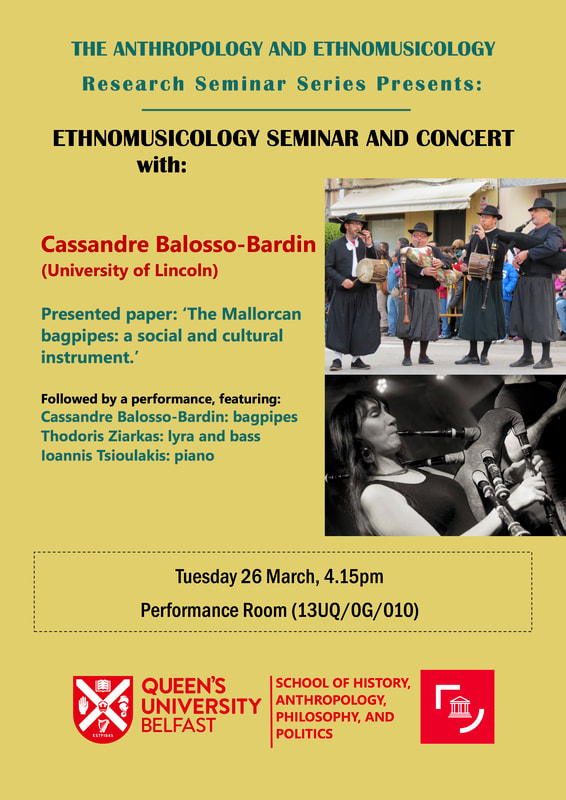
26 March 2019
Guest Lecture/Performance
Queen's University Belfast, Northern Ireland
Title: The Mallorcan bagpipes: a social and cultural instrument.
Performance with Ioannis Tsioulakis and Thodoris Ziarkas
Guest Lecture/Performance
Queen's University Belfast, Northern Ireland
Title: The Mallorcan bagpipes: a social and cultural instrument.
Performance with Ioannis Tsioulakis and Thodoris Ziarkas
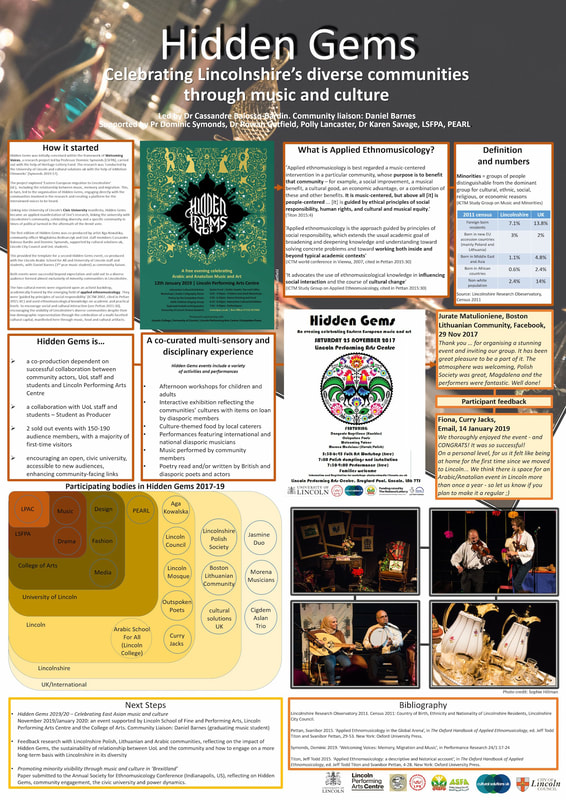
20 March 2019
Conference: PEARL 2019 conference
University of Lincoln, UK
Poster: Hidden Gems: Celebrating Lincolnshire's diverse communities through music and culture
Conference: PEARL 2019 conference
University of Lincoln, UK
Poster: Hidden Gems: Celebrating Lincolnshire's diverse communities through music and culture
20 February 2019
Guest Lecture
Royal Holloway, University of London
Lecture title: Intercultural music making. Practical, social and creative issues
Guest Lecture
Royal Holloway, University of London
Lecture title: Intercultural music making. Practical, social and creative issues
7 November 2018
Guest Lecture
Bath Spa University
Lecture series: Intercultural Communication through Practice
Lecture title: Making music across borders: practical, logistical and musical issues.
Abstract
Using the international world music group Världens Band as a case study, this presentation will explore the issues faced by a band with a utopian goal of cross-border music making. These include not only the logistical practicalities of gathering musicians from different parts of the world to rehearse and play together, anchoring the group in a mobile and technological world, but also the delicate balance of the group whilst creating music and incorporating equal representation ideologies
Guest Lecture
Bath Spa University
Lecture series: Intercultural Communication through Practice
Lecture title: Making music across borders: practical, logistical and musical issues.
Abstract
Using the international world music group Världens Band as a case study, this presentation will explore the issues faced by a band with a utopian goal of cross-border music making. These include not only the logistical practicalities of gathering musicians from different parts of the world to rehearse and play together, anchoring the group in a mobile and technological world, but also the delicate balance of the group whilst creating music and incorporating equal representation ideologies
3 November 2018
Conference: First International Bulgarian Bagpipe Association Conference
Plovdiv Academy, Bulgaria
Paper Title: The bagpiper’s arm. Controlling the bag: a multidimensional study.
In this presentation, I endeavor to show how the bagpiper exerts control on his/her bag. Understanding this may enhance our comprehension of the importance of the arm in a musical context. Our main questions are: what role does the arm have in the control of the instrument? Is the bag controlled with musical intention? Leading from this, further questions can be asked such as how does this influence the instrument’s repertoire and the musician’s performance?
To answer these questions, we will present data collected during three experiments in different cultural contexts and with musicians of different levels. Using acoustic equipment, we were able to measure the insufflated airflow, the pressure in the bag, the angle of the arm as well as make videos and record the sound. In order to complement our scientific data, we carried out an online questionnaire with 215 pipers, which allowed us to gather information on the perception of musicians and their subjective impressions on the control of their instrument. With acoustic measurements, qualitative data and an ethnomusicological framework, this research offers a multidimensional and interdisciplinary study of the control of the bagpipe’s bag.
Conference: First International Bulgarian Bagpipe Association Conference
Plovdiv Academy, Bulgaria
Paper Title: The bagpiper’s arm. Controlling the bag: a multidimensional study.
In this presentation, I endeavor to show how the bagpiper exerts control on his/her bag. Understanding this may enhance our comprehension of the importance of the arm in a musical context. Our main questions are: what role does the arm have in the control of the instrument? Is the bag controlled with musical intention? Leading from this, further questions can be asked such as how does this influence the instrument’s repertoire and the musician’s performance?
To answer these questions, we will present data collected during three experiments in different cultural contexts and with musicians of different levels. Using acoustic equipment, we were able to measure the insufflated airflow, the pressure in the bag, the angle of the arm as well as make videos and record the sound. In order to complement our scientific data, we carried out an online questionnaire with 215 pipers, which allowed us to gather information on the perception of musicians and their subjective impressions on the control of their instrument. With acoustic measurements, qualitative data and an ethnomusicological framework, this research offers a multidimensional and interdisciplinary study of the control of the bagpipe’s bag.
12-15 April 2017
Conference: Europe and post-Brexit Ethnomusicologies, British Forum for Ethnomusicology annual conference
Newcastle University, Newcastle, UK
Panel: Sounding Crisis and Precariousness on the Doorstep of Europe
Paper Title: Staying or Leaving? Greek and Cypriot Musicians in Post-Brexit London
Abstract
Almost every week for the past 18 months, there is news of yet another Greek or Cypriot musician going home, leaving London’s world music hub for good. Some choose to move back indefinitely; others commit to regular commutes for concerts in Europe or decide to try out a flexible arrangement between two or three countries. Often educated in the UK, these are musicians who are and have been actively involved in the diasporic, local, national and international music scenes for years. Paradoxically, many are leaving despite the fact that home is not synonymous with financial prosperity. Indeed, although Cyprus may be faring slightly better economically, Greece is still suffering from the aftermath of the crisis, enduring a seemingly unending and crippling austerity regime, forcing musicians to lower their financial standards and diversify their professional practice (Tsioulakis, forthcoming).
Focusing on individual voices in a post-Brexit environment, this paper explores the rationale behind London-based musicians’ decision making. Based on interviews carried out amongst musicians active in the world music scene, I identify the financial, ideological and practical elements on which post-Brexit Greek and Cypriot musicians base their reasoning. Through this, I wish to highlight the direct impact of Brexit and its on-going debate on the lives of creative international individuals as well the consequences for the cultural life of London and the UK.
Conference: Europe and post-Brexit Ethnomusicologies, British Forum for Ethnomusicology annual conference
Newcastle University, Newcastle, UK
Panel: Sounding Crisis and Precariousness on the Doorstep of Europe
Paper Title: Staying or Leaving? Greek and Cypriot Musicians in Post-Brexit London
Abstract
Almost every week for the past 18 months, there is news of yet another Greek or Cypriot musician going home, leaving London’s world music hub for good. Some choose to move back indefinitely; others commit to regular commutes for concerts in Europe or decide to try out a flexible arrangement between two or three countries. Often educated in the UK, these are musicians who are and have been actively involved in the diasporic, local, national and international music scenes for years. Paradoxically, many are leaving despite the fact that home is not synonymous with financial prosperity. Indeed, although Cyprus may be faring slightly better economically, Greece is still suffering from the aftermath of the crisis, enduring a seemingly unending and crippling austerity regime, forcing musicians to lower their financial standards and diversify their professional practice (Tsioulakis, forthcoming).
Focusing on individual voices in a post-Brexit environment, this paper explores the rationale behind London-based musicians’ decision making. Based on interviews carried out amongst musicians active in the world music scene, I identify the financial, ideological and practical elements on which post-Brexit Greek and Cypriot musicians base their reasoning. Through this, I wish to highlight the direct impact of Brexit and its on-going debate on the lives of creative international individuals as well the consequences for the cultural life of London and the UK.
3-4 April 2018
Invited speaker
Symposium: Music in culturally diverse societies: strategies, social engagement and significance
Sydney Conservatorium of Music, University of Sydney, Australia
This two-day symposium examines the musical activities of communities that have relatively discrete populations and do not form the majority ethnic or cultural group of the societies or countries in which they live.
The aim is (a) to promote a deeper and more nuanced understanding of how minority communities produce and maintain music-making within the context of culturally diverse societies such as Australia and the UK, and (b) thereby better understand the significance of musical activity within non-mainstream cultural groups while (c) taking a global perspective which enables a broad understanding of any common issues that emerge from nationally specific contexts.
The symposium brings together a diverse group of ethnomusicologists from the UK, Australia and elsewhere. The group includes the leading researchers on Australian Aboriginal music – almost all of whom are based at the University of Sydney. The symposium keynote address will be given by Dr Edward Herbst, a leading authority on Balinese music and Balinese musical repatriation. Discussions amongst this group of scholars aim to compare approaches to understanding and supporting minority musical creation, promoting learning from each other’s methodologies, practices, and insights. We anticipate that this will enable the development of more accurately targeted and well-informed applied research projects.
Invited speaker
Symposium: Music in culturally diverse societies: strategies, social engagement and significance
Sydney Conservatorium of Music, University of Sydney, Australia
This two-day symposium examines the musical activities of communities that have relatively discrete populations and do not form the majority ethnic or cultural group of the societies or countries in which they live.
The aim is (a) to promote a deeper and more nuanced understanding of how minority communities produce and maintain music-making within the context of culturally diverse societies such as Australia and the UK, and (b) thereby better understand the significance of musical activity within non-mainstream cultural groups while (c) taking a global perspective which enables a broad understanding of any common issues that emerge from nationally specific contexts.
The symposium brings together a diverse group of ethnomusicologists from the UK, Australia and elsewhere. The group includes the leading researchers on Australian Aboriginal music – almost all of whom are based at the University of Sydney. The symposium keynote address will be given by Dr Edward Herbst, a leading authority on Balinese music and Balinese musical repatriation. Discussions amongst this group of scholars aim to compare approaches to understanding and supporting minority musical creation, promoting learning from each other’s methodologies, practices, and insights. We anticipate that this will enable the development of more accurately targeted and well-informed applied research projects.
|
21 March 2018
Day of the Balearic Islands in Brussels Presentation for the Delegation of the Balearic Islands at the European Union Brussels, Belgium Ceremony: Ethnomusicologist assisting the gift of two Mallorcan instruments to the Musical Instrument Museum of Brussels (pictured) Presentation: Music of the Balearic Islands. An introduction With the contribution of musicians from Ibiza, Mallorca and Menorca Press: https://dbalears.cat/mon/2018/03/22/313201/les-balears-donen-dos-instruments-tradicionals-museu-instruments-musicals-brussel-les.html |
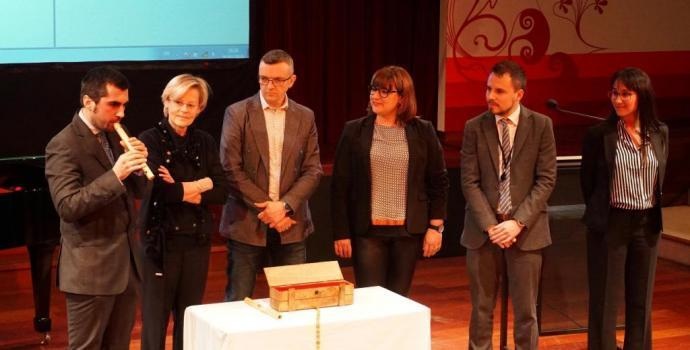
Joan Carles Munar playing the Majorcan cane flute given to the Musical Instruments Museum in Brussels. From left to right: Joan Carles Munar, Alexandra de Poorter (MIM director), Géry Dumoulin (Curator of popular music instruments), Isabel Busquets (Vice President of the Balearic Island Government), Antoni Vicencs (Deputy Director of the Centre Balears Europa in Brussels) and myself.
|
10 March 2018
Conference: International Bagpipe Conference
Mallorca, Spain
Title: The bagpiper’s arm. Controlling the bag: a multidimensional study.
Abstract
Conference: International Bagpipe Conference
Mallorca, Spain
Title: The bagpiper’s arm. Controlling the bag: a multidimensional study.
Abstract
|
Despite their many organological and esthetical differences, bagpipes are all played thanks to the movement of the arm on a bag, creating enough pressure to activate the reeds and produce sound. Unlike fingerings and melodic ornamentation, the musician’s arm technique is rarely discussed in bagpipe literature, nor is it particularly verbalized during a piper’s tuition. According to Simon McKerrell, ‘each player learns it individually and develops their own technique’ (2011). Despite this lack of verbalization, bagpipe experts seem to agree that the breathing technique and the bag are essential elements of their playing (Rice 2011, McKerrell 2011).
In this research, we endeavor to understand how the bagpiper exerts control on his/her bag. Understanding this may enhance our comprehension of the importance of the arm in a musical context. Our main questions are: what role does the arm have in the control of the instrument? Is the bag controlled with musical intention? Leading from this, further questions can be asked such as how does this influence the instrument’s repertoire and the musician’s performance? To answer these questions, we will present data collected during three experiments in different cultural contexts and with musicians of different levels. Using acoustic equipment, we were able to measure the insufflated airflow, the pressure in the bag, the angle of the arm as well as make videos and record the sound. In order to complement our scientific data, we carried out an online questionnaire with 215 pipers, which allowed us to gather information on the perception of musicians and their subjective impressions on the control of their instrument. With acoustic measurements, qualitative data and an ethnomusicological framework, this research offers a multidimensional and interdisciplinary study of the control of the bagpipe’s bag. |
19-23 February 2018
Visiting Lecturer
University of Malta, Malta
Lecture: The materiality of musical instruments
Visiting Lecturer
University of Malta, Malta
Lecture: The materiality of musical instruments
10 January 2018
Presentation for the town of Palma, Mallorca
Title: Les xeremies de Mallorca: un instrument social. Història, ressorgiment i cultura
Presentation for the town of Palma, Mallorca
Title: Les xeremies de Mallorca: un instrument social. Història, ressorgiment i cultura
|
Left: Xeremiers Pau i Candid playing at the opening of the presentation.
Above: Presenting International Bagpipe Conference 2018. |
17 November 2017
Presentation at the Teatre sa Societat, Calvia, Mallorca
Title: Ressorgiment de les xeremies a Mallorca de finals del s. XX
Presentation at the Teatre sa Societat, Calvia, Mallorca
Title: Ressorgiment de les xeremies a Mallorca de finals del s. XX
13-19 July 2017
Conference: ICTM World conference
Irish World Academy of Music and Dance, University of Limerick, Ireland
Paper Title: Understanding an instrument: acoustics, movement and ethnomusicology.
Abstract
Time and time again, extremely talented musicians have pushed the boundaries of musical possibilities. Masters of their instruments to an extremely high level, they set themselves apart within a social and cultural context. This paper proposes to offer a different vision of the control a musician has over their instrument, fuelled both by the humanities and the sciences. An interdisciplinary research project gathering acousticians, engineers and ethnomusicologists focusing on musical gesture, acoustics and music (Geste-Acoustique-Musique) was inaugurated in Paris in 2015 within the Collegium Musicae. Close teamwork between acousticians from the Lutherie-Acoustique-Musique team (Institut d’Alembert, UPMC) and ethnomusicologists from Paris-Sorbonne Université led to a reflection on how collaborative research can inform the musical world, taking into account different actors such as instrument makers, musicians, composers and the audience.
This paper will first present one of the research projects as a case study, namely a musicians’s control of the bagpipe’s bag. Using visual but also acoustic and qualitative data collected over various measurement sessions both in the field and in a laboratory setting, the study will show how the control of an instrument is a two-way dialogue between the instrument (that imposes certain physical and acoustical limits on the musician) and the musician (who can adapt his control in order to bend the instrument to a musical thought) whilst part of an unfixed cultural context.
In a second part, we will illustrate how a closer understanding of the intimate relationship between a musician and his/her instrument can inform ethnomusicological reflection and lead to a broader knowledge of the musical world. This will lead to the presentation of an interdisciplinary reflection, proposing one of many frameworks possible for the study of musical instruments and its cultural, social and musical contexts.
Conference: ICTM World conference
Irish World Academy of Music and Dance, University of Limerick, Ireland
Paper Title: Understanding an instrument: acoustics, movement and ethnomusicology.
Abstract
Time and time again, extremely talented musicians have pushed the boundaries of musical possibilities. Masters of their instruments to an extremely high level, they set themselves apart within a social and cultural context. This paper proposes to offer a different vision of the control a musician has over their instrument, fuelled both by the humanities and the sciences. An interdisciplinary research project gathering acousticians, engineers and ethnomusicologists focusing on musical gesture, acoustics and music (Geste-Acoustique-Musique) was inaugurated in Paris in 2015 within the Collegium Musicae. Close teamwork between acousticians from the Lutherie-Acoustique-Musique team (Institut d’Alembert, UPMC) and ethnomusicologists from Paris-Sorbonne Université led to a reflection on how collaborative research can inform the musical world, taking into account different actors such as instrument makers, musicians, composers and the audience.
This paper will first present one of the research projects as a case study, namely a musicians’s control of the bagpipe’s bag. Using visual but also acoustic and qualitative data collected over various measurement sessions both in the field and in a laboratory setting, the study will show how the control of an instrument is a two-way dialogue between the instrument (that imposes certain physical and acoustical limits on the musician) and the musician (who can adapt his control in order to bend the instrument to a musical thought) whilst part of an unfixed cultural context.
In a second part, we will illustrate how a closer understanding of the intimate relationship between a musician and his/her instrument can inform ethnomusicological reflection and lead to a broader knowledge of the musical world. This will lead to the presentation of an interdisciplinary reflection, proposing one of many frameworks possible for the study of musical instruments and its cultural, social and musical contexts.
18-23 June 2017
Conference: International Symposium on Musical Acoustics
McGill University, Montreal, Canada
Paper Title: Music or Mechanics? Understanding the role of a bagpiper's arm.
Authors: Cassandre Balosso-Bardin, Augustin Ernoult, Patricio de la Cuadra, Ilya Franciosi, Benoit Fabre
Conference: International Symposium on Musical Acoustics
McGill University, Montreal, Canada
Paper Title: Music or Mechanics? Understanding the role of a bagpiper's arm.
Authors: Cassandre Balosso-Bardin, Augustin Ernoult, Patricio de la Cuadra, Ilya Franciosi, Benoit Fabre
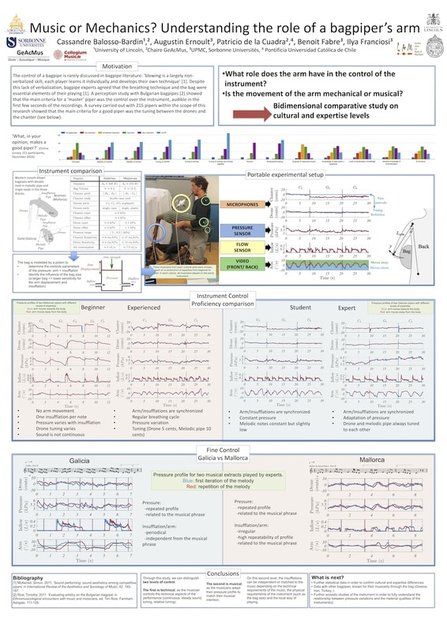
Abstract
Despite their many organological and esthetical differences, bagpipes are all played thanks to the movement of the arm on a bag, creating enough pressure to activate the reeds and produce sound. Repertoires, scales and registers vary according to the instruments and their musical cultures, going from a fully chromatic scale over two octaves (such as the uilleann pipes from Ireland) to a diatonic scale within a range of a sixth (such as the Greek tsampouna or the Tunisian mizwid). Unlike fingerings and melodic ornamentation, the musician’s arm technique is rarely discussed in bagpipe literature, nor is it particularly verbalized during a piper’s tuition. According to Simon McKerrell, ‘each player learns it individually and develops their own technique’ [1]. Despite this lack of verbalization, bagpipe experts seem to agree that the breathing technique and the bag are essential elements of their playing [1],[2].
In this research, carried out during the Geste-Acoustique- Musique program (Sorbonne Universités, Paris), we endeavor to understand how the bagpiper exerts control on his/her bag. Understanding this may enhance our comprehension of the importance of the arm in a musical context. Our main questions are: what role does the arm have in the control of the instrument? Is the bag controlled with musical intention? Leading from this, further questions can be asked such as how does this influence the instrument’s repertoire and the musician’s performance?
To answer these questions, we will present data collected during three experiments in different cultural contexts and with musicians of different levels. Using acoustic equipment, we were able to measure the insufflated airflow, the pressure in the bag, the angle of the arm as well as make videos and record the sound. In order to complement our scientific data, we carried out an online questionnaire, which allowed us to gather information on the perception of musicians and their subjective impressions on the control of their instrument. With acoustic measurements, qualitative data and an ethnomusicological framework, this research offers a multidimensional and interdisciplinary study of the control of the bagpipe’s bag.
REFERENCES
[1] S. McKerrell, “Sound performing: sound aesthetics among competitive pipers,” in International review of the aesthetcs and sociology of music, 42/1. Croatian Musicological Society, 2011.
[2] T. Rice, “Evaluating artistry on the Bulgarian bagpipes,” in Ethnomusicological encounters with music and musicians. Farnham, Ashgate Publishing Limited, 2011.
Despite their many organological and esthetical differences, bagpipes are all played thanks to the movement of the arm on a bag, creating enough pressure to activate the reeds and produce sound. Repertoires, scales and registers vary according to the instruments and their musical cultures, going from a fully chromatic scale over two octaves (such as the uilleann pipes from Ireland) to a diatonic scale within a range of a sixth (such as the Greek tsampouna or the Tunisian mizwid). Unlike fingerings and melodic ornamentation, the musician’s arm technique is rarely discussed in bagpipe literature, nor is it particularly verbalized during a piper’s tuition. According to Simon McKerrell, ‘each player learns it individually and develops their own technique’ [1]. Despite this lack of verbalization, bagpipe experts seem to agree that the breathing technique and the bag are essential elements of their playing [1],[2].
In this research, carried out during the Geste-Acoustique- Musique program (Sorbonne Universités, Paris), we endeavor to understand how the bagpiper exerts control on his/her bag. Understanding this may enhance our comprehension of the importance of the arm in a musical context. Our main questions are: what role does the arm have in the control of the instrument? Is the bag controlled with musical intention? Leading from this, further questions can be asked such as how does this influence the instrument’s repertoire and the musician’s performance?
To answer these questions, we will present data collected during three experiments in different cultural contexts and with musicians of different levels. Using acoustic equipment, we were able to measure the insufflated airflow, the pressure in the bag, the angle of the arm as well as make videos and record the sound. In order to complement our scientific data, we carried out an online questionnaire, which allowed us to gather information on the perception of musicians and their subjective impressions on the control of their instrument. With acoustic measurements, qualitative data and an ethnomusicological framework, this research offers a multidimensional and interdisciplinary study of the control of the bagpipe’s bag.
REFERENCES
[1] S. McKerrell, “Sound performing: sound aesthetics among competitive pipers,” in International review of the aesthetcs and sociology of music, 42/1. Croatian Musicological Society, 2011.
[2] T. Rice, “Evaluating artistry on the Bulgarian bagpipes,” in Ethnomusicological encounters with music and musicians. Farnham, Ashgate Publishing Limited, 2011.
Paper Title: Reconstructing an 1832 Boehm conical flute: an interdisciplinary collaboration
Authors: Cassandre Balosso-Bardin, Patricio de la Cuadra, Camille Vauthrin, Benoit Fabre
Authors: Cassandre Balosso-Bardin, Patricio de la Cuadra, Camille Vauthrin, Benoit Fabre
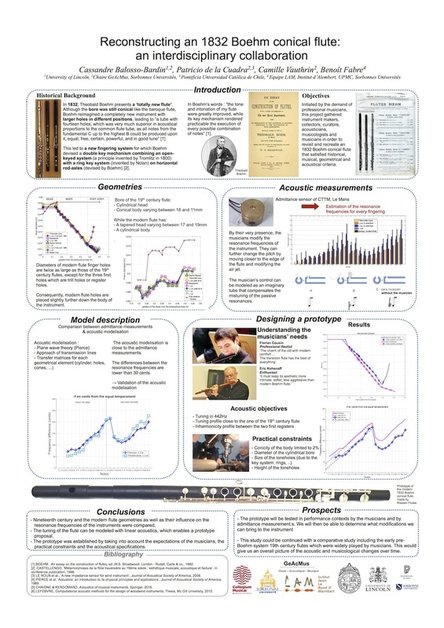
Abstract
In 1832, flute-maker Theobald Boehm launches a brand new flute after conducting a series of acoustical experiments. The result was a flute with a conical bore, and a revolutionary key-system borrowing the best elements from different contemporary flute-makers to accommodate a complete modification of the instrument’s tone holes. However, he did not patent his 1832 model and “left it free for use and imitation” [1]. This means that despite its short life-span – by 1848 Boehm had already invented the modern flute with a cylindrical bore – and much rivalry from other manufacturers, the 1832 flute was built by many renowned makers until the first decades of the 20th century. Thus, although this instrument – that we named transition flute – was based on a specific model developed by Boehm, there was space for a wide variety of models. The lack of standardization means that when flautists play on transition flutes today, they are confronted to a wide variety of choice as each instrument is different.When commissioned by musicians to build a transition flute based on the 1832 conical model, the Flutes Roosen workshop was faced with a dilemma as the flutes all varied significantly. The following article shows how the geometrical and acoustic study of four transition flutes allowed us to propose a computer-generated model that simultaneously respected Boehm’s inventions and took into account the variety of models available. Rather than produce an exact copy of one instrument, we opted for recreating a new flute based on acoustic and geometrical measurements of different transition flutes and on Boehm’s desired improvements, detailed in his 1847 Essay on the construction of flutes [1].
REFERENCES
[1] T. Boehm, An essay on the construction of flutes. London: Rudall, Carte&co, 1832.
In 1832, flute-maker Theobald Boehm launches a brand new flute after conducting a series of acoustical experiments. The result was a flute with a conical bore, and a revolutionary key-system borrowing the best elements from different contemporary flute-makers to accommodate a complete modification of the instrument’s tone holes. However, he did not patent his 1832 model and “left it free for use and imitation” [1]. This means that despite its short life-span – by 1848 Boehm had already invented the modern flute with a cylindrical bore – and much rivalry from other manufacturers, the 1832 flute was built by many renowned makers until the first decades of the 20th century. Thus, although this instrument – that we named transition flute – was based on a specific model developed by Boehm, there was space for a wide variety of models. The lack of standardization means that when flautists play on transition flutes today, they are confronted to a wide variety of choice as each instrument is different.When commissioned by musicians to build a transition flute based on the 1832 conical model, the Flutes Roosen workshop was faced with a dilemma as the flutes all varied significantly. The following article shows how the geometrical and acoustic study of four transition flutes allowed us to propose a computer-generated model that simultaneously respected Boehm’s inventions and took into account the variety of models available. Rather than produce an exact copy of one instrument, we opted for recreating a new flute based on acoustic and geometrical measurements of different transition flutes and on Boehm’s desired improvements, detailed in his 1847 Essay on the construction of flutes [1].
REFERENCES
[1] T. Boehm, An essay on the construction of flutes. London: Rudall, Carte&co, 1832.
1-4 June 2017
Conference: Galpin Society/AMIS Conference on Musical Instruments
Edinburgh, UK
Paper Title: The bagpiper’s arm. Controlling the bag: a multidimensional study.
Abstract
Despite their many organological and esthetical differences, bagpipes are all played thanks to the movement of the arm on a bag, creating enough pressure to activate the reeds and produce sound. Repertoires, scales and registers vary according to the instruments and their musical cultures, going from a fully chromatic scale over two octaves (such as the uilleann pipes from Ireland) to a diatonic scale within a range of a sixth (such as the Greek tsampouna or the Tunisian mizwid). Unlike fingerings and melodic ornamentation, the musician’s arm technique is rarely discussed in bagpipe literature, nor is it particularly verbalized during a piper’s tuition. According to Simon McKerrell, ‘each player learns it individually and develops their own technique’ (2011). Despite this lack of verbalization, bagpipe experts seem to agree that the breathing technique and the bag are essential elements of their playing (Rice 2011, McKerrell 2011).
In this research, we endeavor to understand how the bagpiper exerts control on his/her bag. Understanding this may enhance our comprehension of the importance of the arm in a musical context. Our main questions are: what role does the arm have in the control of the instrument? Is the bag controlled with musical intention? Leading from this, further questions can be asked such as how does this influence the instrument’s repertoire and the musician’s performance?
To answer these questions, we will present data collected during three experiments in different cultural contexts and with musicians of different levels. Using acoustic equipment, we were able to measure the insufflated airflow, the pressure in the bag, the angle of the arm as well as make videos and record the sound. In order to complement our scientific data, we carried out an online questionnaire, which allowed us to gather information on the perception of musicians and their subjective impressions on the control of their instrument. With acoustic measurements, qualitative data and an ethnomusicological framework, this research offers a multidimensional and interdisciplinary study of the control of the bagpipe’s bag.
Conference: Galpin Society/AMIS Conference on Musical Instruments
Edinburgh, UK
Paper Title: The bagpiper’s arm. Controlling the bag: a multidimensional study.
Abstract
Despite their many organological and esthetical differences, bagpipes are all played thanks to the movement of the arm on a bag, creating enough pressure to activate the reeds and produce sound. Repertoires, scales and registers vary according to the instruments and their musical cultures, going from a fully chromatic scale over two octaves (such as the uilleann pipes from Ireland) to a diatonic scale within a range of a sixth (such as the Greek tsampouna or the Tunisian mizwid). Unlike fingerings and melodic ornamentation, the musician’s arm technique is rarely discussed in bagpipe literature, nor is it particularly verbalized during a piper’s tuition. According to Simon McKerrell, ‘each player learns it individually and develops their own technique’ (2011). Despite this lack of verbalization, bagpipe experts seem to agree that the breathing technique and the bag are essential elements of their playing (Rice 2011, McKerrell 2011).
In this research, we endeavor to understand how the bagpiper exerts control on his/her bag. Understanding this may enhance our comprehension of the importance of the arm in a musical context. Our main questions are: what role does the arm have in the control of the instrument? Is the bag controlled with musical intention? Leading from this, further questions can be asked such as how does this influence the instrument’s repertoire and the musician’s performance?
To answer these questions, we will present data collected during three experiments in different cultural contexts and with musicians of different levels. Using acoustic equipment, we were able to measure the insufflated airflow, the pressure in the bag, the angle of the arm as well as make videos and record the sound. In order to complement our scientific data, we carried out an online questionnaire, which allowed us to gather information on the perception of musicians and their subjective impressions on the control of their instrument. With acoustic measurements, qualitative data and an ethnomusicological framework, this research offers a multidimensional and interdisciplinary study of the control of the bagpipe’s bag.
20-23 April 2017
Conference: British Forum for Ethnomusicology annual conference
Sheffield, UK
Paper Title: The rise of amateur xeremiers (bagpipers) - a post revival trend in Mallorca
Abstract
“Playing the xeremies is like having my own personal therapy” once told me a xeremies enthusiast. Since 2001, he drives to the other end of the island every Monday in order to rehearse with his bagpipe group. Since the late 1990s and early 2000s, the number of people who started playing the xeremies has steadily been on the rise, most of them taking it up as a hobby, using the bagpipes to promote their local identity as well as increase social interaction during their leisure time. Today, over 600 people play the instrument compared to a mere dozen in the 1970s.
The Mallorcan revival in the 1980s was characterised by social, economic and geographical shifts (after Ronström 2014). One of the main factors that allowed the bagpipe tradition not only to survive during the course of the 20th century but also to develop into a thriving revival was the professionalization of the musicians, which enabled them to focus mainly on the instrument and the music. A successful revival allowed the Mallorcan bagpipes to enter a postrevival phase where they were no longer endangered (Bithell and Hill 2014:29). Within this phase, amateur musicians became much more prominent, at times taking over niches created by professional xeremiers.
This paper will explore the shift to an amateur practice, reflecting on its impact on tradition. Indeed, although the act of playing the instrument remains, the cultural context changes, leading to important social and economic shifts. Through the analysis of data collected during fieldwork in 2011 and 2012, I will endeavour to answer the following questions: How are amateur performances perceived? Are there any aspects of the tradition that discarded in favour of other elements more relevant to today’s practice? And finally, what is the impact on the cultural context, music and musicians?
Conference: British Forum for Ethnomusicology annual conference
Sheffield, UK
Paper Title: The rise of amateur xeremiers (bagpipers) - a post revival trend in Mallorca
Abstract
“Playing the xeremies is like having my own personal therapy” once told me a xeremies enthusiast. Since 2001, he drives to the other end of the island every Monday in order to rehearse with his bagpipe group. Since the late 1990s and early 2000s, the number of people who started playing the xeremies has steadily been on the rise, most of them taking it up as a hobby, using the bagpipes to promote their local identity as well as increase social interaction during their leisure time. Today, over 600 people play the instrument compared to a mere dozen in the 1970s.
The Mallorcan revival in the 1980s was characterised by social, economic and geographical shifts (after Ronström 2014). One of the main factors that allowed the bagpipe tradition not only to survive during the course of the 20th century but also to develop into a thriving revival was the professionalization of the musicians, which enabled them to focus mainly on the instrument and the music. A successful revival allowed the Mallorcan bagpipes to enter a postrevival phase where they were no longer endangered (Bithell and Hill 2014:29). Within this phase, amateur musicians became much more prominent, at times taking over niches created by professional xeremiers.
This paper will explore the shift to an amateur practice, reflecting on its impact on tradition. Indeed, although the act of playing the instrument remains, the cultural context changes, leading to important social and economic shifts. Through the analysis of data collected during fieldwork in 2011 and 2012, I will endeavour to answer the following questions: How are amateur performances perceived? Are there any aspects of the tradition that discarded in favour of other elements more relevant to today’s practice? And finally, what is the impact on the cultural context, music and musicians?
18-20 November 2016
Conference: Journées de Musique Ancienne de Vanves
Vanves, France
Paper Title: La réinvention d’un instrument traditionnel: le renouveau de la cornemuse de Malloque (xeremies)
Abstract
L’île de Majorque est peu connue pour ses cornemuses. Celles-ci font pourtant partie de l’instrumentarium local depuis le XIII siècle, présentes à la fois dans les archives écrites et dans l’iconographie. Cependant, le modèle de cornemuse actuellement joué a été développé dans une période postmédiévale. Les premiers exemples de xeremies dotées de la morphologie moderne (tuyau d’insufflation, tuyau mélodique et une souche avec trois bourdons orientés vers le bas) se trouvent parmi les figurines de scènes de nativité datées de la fin du XVII siècle. Au XX siècle, les xeremies connurent d’abord un déclin puis un nouvel essor à la fin années 1970 dans un mouvement de renouveau (ou revival) commun aux musiques traditionnelles américaines et européennes. L’une des caractéristiques uniques du revival Majorquin fut la transmission ininterrompue des savoirs musicaux grâce à une ancienne génération de musiciens ruraux encore en activité. Cependant, la transmission de musique à la nouvelle génération fut fortement gênée par l’absence d’instruments de bonne qualité. En effet, la facture des xeremies avait complètement disparue depuis le début du XX siècle, ne laissant que des musiciens bricoleurs qui confiaient le tournage de nouvelles pièces à des artisans non spécialisés tels que des cordonniers ou fabricants de sommiers. Le début du revival des années 1980 se caractérisa donc par une nouvelle facture de xeremies, fortement liée à la pratique des jeunes musiciens.
Cette communication se base sur un travail de terrain effectué dans le cadre d’une thèse doctorale. Nous retracerons le travail des pionniers du renouveau des xeremies, soulignant notamment une collaboration entre facteurs et musiciens au cours des années afin d’élaborer un instrument satisfaisant à la fois les contraintes organologiques liées à l’identité visuelle et sonore de l’instrument (morphologie, timbre...) et le développement technique des instrumentistes souhaitant des instruments capables de jouer selon leurs critères techniques (gamme standardisée, matériaux stables...). Nous regarderons également de près le travail de reconstitution de Joan Morey, le premier facteur de xeremies depuis le début du XX siècle, ainsi que le travail de deux musiciens qui ont poussé la facture des xeremies plus loin en travaillant avec des facteurs galiciens, asturiens et catalans afin d’obtenir un prototype convenant à leur besoins musicaux et techniques. Enfin, un dernier regard se portera sur la réception de ces nouveaux instruments, notamment la réaction de l’ancienne génération des joueurs de xeremies.
Conference: Journées de Musique Ancienne de Vanves
Vanves, France
Paper Title: La réinvention d’un instrument traditionnel: le renouveau de la cornemuse de Malloque (xeremies)
Abstract
L’île de Majorque est peu connue pour ses cornemuses. Celles-ci font pourtant partie de l’instrumentarium local depuis le XIII siècle, présentes à la fois dans les archives écrites et dans l’iconographie. Cependant, le modèle de cornemuse actuellement joué a été développé dans une période postmédiévale. Les premiers exemples de xeremies dotées de la morphologie moderne (tuyau d’insufflation, tuyau mélodique et une souche avec trois bourdons orientés vers le bas) se trouvent parmi les figurines de scènes de nativité datées de la fin du XVII siècle. Au XX siècle, les xeremies connurent d’abord un déclin puis un nouvel essor à la fin années 1970 dans un mouvement de renouveau (ou revival) commun aux musiques traditionnelles américaines et européennes. L’une des caractéristiques uniques du revival Majorquin fut la transmission ininterrompue des savoirs musicaux grâce à une ancienne génération de musiciens ruraux encore en activité. Cependant, la transmission de musique à la nouvelle génération fut fortement gênée par l’absence d’instruments de bonne qualité. En effet, la facture des xeremies avait complètement disparue depuis le début du XX siècle, ne laissant que des musiciens bricoleurs qui confiaient le tournage de nouvelles pièces à des artisans non spécialisés tels que des cordonniers ou fabricants de sommiers. Le début du revival des années 1980 se caractérisa donc par une nouvelle facture de xeremies, fortement liée à la pratique des jeunes musiciens.
Cette communication se base sur un travail de terrain effectué dans le cadre d’une thèse doctorale. Nous retracerons le travail des pionniers du renouveau des xeremies, soulignant notamment une collaboration entre facteurs et musiciens au cours des années afin d’élaborer un instrument satisfaisant à la fois les contraintes organologiques liées à l’identité visuelle et sonore de l’instrument (morphologie, timbre...) et le développement technique des instrumentistes souhaitant des instruments capables de jouer selon leurs critères techniques (gamme standardisée, matériaux stables...). Nous regarderons également de près le travail de reconstitution de Joan Morey, le premier facteur de xeremies depuis le début du XX siècle, ainsi que le travail de deux musiciens qui ont poussé la facture des xeremies plus loin en travaillant avec des facteurs galiciens, asturiens et catalans afin d’obtenir un prototype convenant à leur besoins musicaux et techniques. Enfin, un dernier regard se portera sur la réception de ces nouveaux instruments, notamment la réaction de l’ancienne génération des joueurs de xeremies.
7-9 September 2016
Conference: Woodmusick 2016
Barcelona, Spain
Paper Title: Rethinking the possibilities of a notched flute: the case of the quena
Authors: Cassandre Balosso-Bardin, Patricio de la Cuadra, Camille Vauthrin, Benoit Fabre
Abstract
The quena is a notched flute from South America. Notched flutes share the same excitation mechanism but differ in several aspects such as the number of holes, the geometry of the notch and the size and shape of the tube. Today the quena is an instrument widely played in Latin America both in rural and urban contexts, where it gradually adapted to tonal music. It is in the latter context that we propose to revise the design of the bamboo quena from an acoustic perspective, optimizing the position of the toneholes and modifying the geometry of the bore in order to obtain a flexible and adequate instrument not only to play tonal music but also to adapt to the chromatic needs of contemporary music. The analysis is based on a linear model of the acoustical propagation inside the instrument, which is numerically simulated and optimized in order to obtain a new design of the instrument addressing some of the limitations found in the original cylindrical quenas.
Conference: Woodmusick 2016
Barcelona, Spain
Paper Title: Rethinking the possibilities of a notched flute: the case of the quena
Authors: Cassandre Balosso-Bardin, Patricio de la Cuadra, Camille Vauthrin, Benoit Fabre
Abstract
The quena is a notched flute from South America. Notched flutes share the same excitation mechanism but differ in several aspects such as the number of holes, the geometry of the notch and the size and shape of the tube. Today the quena is an instrument widely played in Latin America both in rural and urban contexts, where it gradually adapted to tonal music. It is in the latter context that we propose to revise the design of the bamboo quena from an acoustic perspective, optimizing the position of the toneholes and modifying the geometry of the bore in order to obtain a flexible and adequate instrument not only to play tonal music but also to adapt to the chromatic needs of contemporary music. The analysis is based on a linear model of the acoustical propagation inside the instrument, which is numerically simulated and optimized in order to obtain a new design of the instrument addressing some of the limitations found in the original cylindrical quenas.
|
3 September 2016
Conference: Presentation of my thesis, The Mallorcan bagpipes (xeremies): an anthropological portrait of an instrument. Pollença, Mallorca On 3 September 2016, I will present my thesis to the people who most helped me during my research: the xeremiers and Mallorcans who welcomed me to their world for a year. The event, organised at the Claustre de Sant Domingo in Pollença, will feature a talk intersperced with musical moments. In Spanish and open to the public, all will have the opportunity to ask questions about one of Mallorca's most traditional instrument. We look forward to welcoming you to Pollença. |
21-16 June 2016
Conference: ICTM Study Group Mediterranean Music Studies and the International Musicological Society “Musicians in the Mediterranean: Narratives of Movement”
Naples, Italy
Paper Title: Moving from the front to the back region: the invisibility act of the Mallorcan bagpipes (xeremies) in a mass-tourism context
Abstract
Since the 1950s, Mallorca has been the chosen destination for millions of tourists. The surge of mass tourism led islanders to shift to service-based industries, leading to a decline in old ways of life (Barceló 2000, Waldren 1997). Elements of tradition were showcased in controlled "front region" contexts – locations where tourists interacted with local performers such as hotels and restaurants (after MacCannell 1973). At the same time, in the "back region," locals continued to interact far from the tourist gaze (after Urry (1990) 2002), especially after the fall of the authoritarian government in 1975. While the regime had used folklore for ideological promotion, it could now be reclaimed by a handful of musicians who initiated what became a successful revival. In the case of Mallorcan bagpipes, the xeremies, there was a sharp increase in players from the 1990s onwards. As traditional music and dance began to thrive again, it moved away from staged folklore performances. This matched a decline in the use of folk music within tourism, as fewer businesses booked shows. Much as Boissevain (2004) shows with local residents in Malta, Mallorcan musicians developed strategies to hide local culture from the prying eyes of the "forrasters", the outsiders. Using the case study of the xeremies, this paper explores the resistance mechanisms developed by local musicians and residents to protect their culture and develop it on their own terms. I chart how, over time, the activity of these musicians moved within the island to a back regiond and became virtually invisible to Mallorca ́s numerous tourists.
Conference: ICTM Study Group Mediterranean Music Studies and the International Musicological Society “Musicians in the Mediterranean: Narratives of Movement”
Naples, Italy
Paper Title: Moving from the front to the back region: the invisibility act of the Mallorcan bagpipes (xeremies) in a mass-tourism context
Abstract
Since the 1950s, Mallorca has been the chosen destination for millions of tourists. The surge of mass tourism led islanders to shift to service-based industries, leading to a decline in old ways of life (Barceló 2000, Waldren 1997). Elements of tradition were showcased in controlled "front region" contexts – locations where tourists interacted with local performers such as hotels and restaurants (after MacCannell 1973). At the same time, in the "back region," locals continued to interact far from the tourist gaze (after Urry (1990) 2002), especially after the fall of the authoritarian government in 1975. While the regime had used folklore for ideological promotion, it could now be reclaimed by a handful of musicians who initiated what became a successful revival. In the case of Mallorcan bagpipes, the xeremies, there was a sharp increase in players from the 1990s onwards. As traditional music and dance began to thrive again, it moved away from staged folklore performances. This matched a decline in the use of folk music within tourism, as fewer businesses booked shows. Much as Boissevain (2004) shows with local residents in Malta, Mallorcan musicians developed strategies to hide local culture from the prying eyes of the "forrasters", the outsiders. Using the case study of the xeremies, this paper explores the resistance mechanisms developed by local musicians and residents to protect their culture and develop it on their own terms. I chart how, over time, the activity of these musicians moved within the island to a back regiond and became virtually invisible to Mallorca ́s numerous tourists.
13-15 June 2016
Conference: EuroRegio 2016
Porto, Portugal
Paper Title: The musical arm of the bagpipe player : a cultural and mechanical approach
Abstract
There are over 130 different types of bagpipes in the world, from India to Ireland, Sweden to Turkey. Despite their many organological and esthetical differences, they are all played thanks to the movement of the arm on a bag, creating enough pressure to activate the reeds and produce a melody. Repertoires, scales and registers vary according to the instruments and their musical cultures, going from a fully chromatic scale over two octaves to a diatonic scale within a range of a sixth. Ornamentation can be both stylistic and practical. It allows the expressive variation of the music through the illusion of detached or legato phrases. Indeed, bar a few exceptions, the nature of the instrument does not allow the separation of notes, such as can be played on other wind instruments through tonguing. The fingers are therefore a key element to musical expression.
However, depending on the morphology of the bagpipe, the arm can also become a more or less important element for the musician’s performance. A simple mechanical action, providing a constant source of air that allows the reeds to vibrate continuously, the arm can also become an integral part of the musical expressivity of the player, adding an extra layer to the music and its ornamentation. These musical movements, embedded in the instrument’s culture and repertoire, are facilitated through the combination of the reeds, the melodic pipe and the bag.
This presentation will be in two parts. First, I will present different bagpipe traditions in order to illustrate the different uses of the arm following the organology of the instrument and its repertoire. Secondly, I will present the experiment protocol and its first paradygmatic results with the music recorded. These will allow us to measure the effort produced by the activity of the arm on the bag and the variations of pressure in the latter. It will also allow us to measure the synchronicity between the breathing of the musician and/or the musical performance in order to answer the following questions: what role does the arm have in the control of the instrument? And how does this influence the instrument’s repertoire and the musician’s performance ?
Conference: EuroRegio 2016
Porto, Portugal
Paper Title: The musical arm of the bagpipe player : a cultural and mechanical approach
Abstract
There are over 130 different types of bagpipes in the world, from India to Ireland, Sweden to Turkey. Despite their many organological and esthetical differences, they are all played thanks to the movement of the arm on a bag, creating enough pressure to activate the reeds and produce a melody. Repertoires, scales and registers vary according to the instruments and their musical cultures, going from a fully chromatic scale over two octaves to a diatonic scale within a range of a sixth. Ornamentation can be both stylistic and practical. It allows the expressive variation of the music through the illusion of detached or legato phrases. Indeed, bar a few exceptions, the nature of the instrument does not allow the separation of notes, such as can be played on other wind instruments through tonguing. The fingers are therefore a key element to musical expression.
However, depending on the morphology of the bagpipe, the arm can also become a more or less important element for the musician’s performance. A simple mechanical action, providing a constant source of air that allows the reeds to vibrate continuously, the arm can also become an integral part of the musical expressivity of the player, adding an extra layer to the music and its ornamentation. These musical movements, embedded in the instrument’s culture and repertoire, are facilitated through the combination of the reeds, the melodic pipe and the bag.
This presentation will be in two parts. First, I will present different bagpipe traditions in order to illustrate the different uses of the arm following the organology of the instrument and its repertoire. Secondly, I will present the experiment protocol and its first paradygmatic results with the music recorded. These will allow us to measure the effort produced by the activity of the arm on the bag and the variations of pressure in the latter. It will also allow us to measure the synchronicity between the breathing of the musician and/or the musical performance in order to answer the following questions: what role does the arm have in the control of the instrument? And how does this influence the instrument’s repertoire and the musician’s performance ?
14-17 April 2016
Conference: British Forum for Ethnomusicology, Annual Conference
Chatham, Kent, UK
Paper Title: Pipers versus pirates: the ritual role of bagpipes during Sóller’s annual Firó celebration.
Abstract
Every year, the citizens of Sóller re-enact a corsair attack perpetrated in 1561 on the small coastal Mallorcan town. Local collectives annually organise the upcoming Firó celebration during which the inhabitants of Sóller dress up as Christian peasants or Moorish pirates to relive the disembarkment of Ulutx Alí’s fleet, as well as the ensuing battles in the port and in the town. Framed by ritual celebrations before and after the battles, the apex is reached on the final day where the Christians converge in the main square to witness the defeat of the pirates, hung from the trees or fleeing the victorious town. Despite the historical specificity of this event, Christian and Moor celebrations are carried out in many different Spanish regions including Andalucía, Alicante and Valencia (Evers Rosanders 2001:149) along with other variations in Italy (Barwick 2014) and Mexico (Harris 2000). Evers Rosanders links them to the success of the reconquista after ‘800 years of Islamic dominance’ (2001:149).
In this paper, I shall examine the role of the local bagpipers, the Xeremiers de Sóller, during the festivities. After a short historical overview of the Christian and Moor celebrations, I shall explore how the local bagpipers are intricately linked to the celebration. Not only did the group emerge from the Firó celebrations, the pipers also benefit from a special status both during the event and throughout the year. This, I argue, shows that the Xeremiers de Sóller fulfill the traditional role of the colla, the Mallorcan bagpipe duet formation. Central to the Firó, they open and close the celebrations with their music, leading the citizens into a liminal state from which they emerge with a renewed sense of belonging and patriotism towards their hometown. Finally, I will raise questions about the impact of such celebrations in today’s fast-changing political context.
11 March 2016
Conference: 4eme journée des chercheurs du GREAM
Strasbourg, France
Paper Title: Le bras musical du joueur de cornemuse: approche culturelle et mécanique.
Abstract
Il y a plus de 130 différentes cornemuses dans le monde, de l’Inde à l’Irlande, de la Suède à la Tunisie. Malgré leurs différences organologiques et esthétiques, toutes sont actionnées par un mouvement de bras sur le sac, exerçant une pression afin de pouvoir jouer une mélodie. Selon l’instrument et les cultures, les mélodies diffèrent, utilisant des gammes et registres propres aux instruments : du chromatisme complet sur deux octaves à une gamme diatonique avec un ambitus de sixte. L’ornementation utilisée par les joueurs est à la fois stylistique et pratique. Elle permet de varier l’expression musicale grâce à des roulés, des retours à la tonique ou encore des notes extrêmement rapides afin de donner l’illusion de détaché. En effet, à quelques exceptions près, la nature de l’instrument ne permet pas de séparer les notes tel que le ferait un autre instrument à vent avec des coups de langue. Les doigts sont donc nécessaires à l’expressivité musicale.
Cependant, en fonction de la facture de la cornemuse, le bras peut également devenir un élément plus ou moins important dans le jeu du musicien. De la simple action mécanique permettant un souffle continu maintenant la vibration ininterrompue des anches, le bras peut devenir partie intégrante l’expression musicale, ajoutant une dimension supplémentaire à l’ornementation du répertoire. Ces mouvements musicaux, intégrés dans le contexte culturel de l’instrument, sont rendus possible grâce à la combinaison matérielle des anches, du tuyau mélodique et du sac.
Cette présentation se divisera en deux parties. Tout d’abord, différentes cornemuses seront présentées afin d’illustrer les différences d’utilisation du bras et du sac dans leurs contextes musicaux et culturels. Ensuite, je présenterai le protocole d’expérimentation mis en place au sein de la Chaire GeAcMus (Geste Acoustique Musique, UPMC-Paris Sorbonne) qui permettra de mesurer l’effort produit par l’action du bras sur le sac, et donc les variations de pression dans ce dernier. Ceci nous permettra d’évaluer la synchronisation avec la respiration du musicien et/ou le jeu musical afin de répondre aux questions suivantes : comment intervient le bras dans le contrôle de l'instrument ? et comment cela se répercute-t-il sur le répertoire de l’instrument ?
Conference: 4eme journée des chercheurs du GREAM
Strasbourg, France
Paper Title: Le bras musical du joueur de cornemuse: approche culturelle et mécanique.
Abstract
Il y a plus de 130 différentes cornemuses dans le monde, de l’Inde à l’Irlande, de la Suède à la Tunisie. Malgré leurs différences organologiques et esthétiques, toutes sont actionnées par un mouvement de bras sur le sac, exerçant une pression afin de pouvoir jouer une mélodie. Selon l’instrument et les cultures, les mélodies diffèrent, utilisant des gammes et registres propres aux instruments : du chromatisme complet sur deux octaves à une gamme diatonique avec un ambitus de sixte. L’ornementation utilisée par les joueurs est à la fois stylistique et pratique. Elle permet de varier l’expression musicale grâce à des roulés, des retours à la tonique ou encore des notes extrêmement rapides afin de donner l’illusion de détaché. En effet, à quelques exceptions près, la nature de l’instrument ne permet pas de séparer les notes tel que le ferait un autre instrument à vent avec des coups de langue. Les doigts sont donc nécessaires à l’expressivité musicale.
Cependant, en fonction de la facture de la cornemuse, le bras peut également devenir un élément plus ou moins important dans le jeu du musicien. De la simple action mécanique permettant un souffle continu maintenant la vibration ininterrompue des anches, le bras peut devenir partie intégrante l’expression musicale, ajoutant une dimension supplémentaire à l’ornementation du répertoire. Ces mouvements musicaux, intégrés dans le contexte culturel de l’instrument, sont rendus possible grâce à la combinaison matérielle des anches, du tuyau mélodique et du sac.
Cette présentation se divisera en deux parties. Tout d’abord, différentes cornemuses seront présentées afin d’illustrer les différences d’utilisation du bras et du sac dans leurs contextes musicaux et culturels. Ensuite, je présenterai le protocole d’expérimentation mis en place au sein de la Chaire GeAcMus (Geste Acoustique Musique, UPMC-Paris Sorbonne) qui permettra de mesurer l’effort produit par l’action du bras sur le sac, et donc les variations de pression dans ce dernier. Ceci nous permettra d’évaluer la synchronisation avec la respiration du musicien et/ou le jeu musical afin de répondre aux questions suivantes : comment intervient le bras dans le contrôle de l'instrument ? et comment cela se répercute-t-il sur le répertoire de l’instrument ?
26-28 February 2016
Conference: International Bagpipe Conference 2016 (founder and organiser)
Glasgow, Scotland
Organised by the International Bagpipe Organisation in collaboration with the National Piping Centre, the Royal Conservatoire of Scotland and Glasgow University with the support of the Bagpipe Society, the Lowland and Border Piping Society, the Piobriaech Society, the Northumbrian Piping Society and the William Grant & Sons foundation.
Bagpipe musicians, academics and enthusiasts from all around the world will gather at the National Piping Centre from 26 Feb to 28 Feb 2016 for the third edition of the biennal International Bagpipe Conference.
List of papers to be presented at the 2016 conference.
Conference: International Bagpipe Conference 2016 (founder and organiser)
Glasgow, Scotland
Organised by the International Bagpipe Organisation in collaboration with the National Piping Centre, the Royal Conservatoire of Scotland and Glasgow University with the support of the Bagpipe Society, the Lowland and Border Piping Society, the Piobriaech Society, the Northumbrian Piping Society and the William Grant & Sons foundation.
Bagpipe musicians, academics and enthusiasts from all around the world will gather at the National Piping Centre from 26 Feb to 28 Feb 2016 for the third edition of the biennal International Bagpipe Conference.
List of papers to be presented at the 2016 conference.
- Socio-economic development in later 20th century Scotland: Bagpiping and Pipe band competition (Andy Clark)
- Boha, evolution or invention ? (Jean Michel Espinasse and Yan Cozian)
- Old Polish Bagpipes Recording From Archival Sources. Phonographic Collection In The Institute Of Art Of The Polish Academy Of Science (Ewelina Grygier)
- Self-Othering and the Revival of the English Border Bagpipes (Roger Landes)
- Representations of the bagpipe in the Irish press 1770-1970 (Ciarán MacMurchaidh)
- Swamibapa Salute (film) (Hannah Marsden)
- What is the value of piping? (Simon McKerrell)
- Key bagpipe from Southern Italy. Organology, manufacture and analysis of repertory (Nada Gitto)
- The Maltese Zaqq – a Little-known European Bagpipe (Karl Partridge)
- Piobaireachd Society: Piobaireachd. An oral tradition preserved (Jack Taylor)
- Bagpipes and pipers (film) (Mariusz Raniszewski)
- Bagpipers in the city of fado? Bagpipe Teaching in Lisbon (Susana Moreno Fernández)
- 250 years evolution of the monoxyle drones musette: Historical and organological study (Jean-Pierre Van Hees)
- Kaba Gaida Traditions and Present (Cvetelin Andreev)
- The history and present state of ukrainian bagpipes (Viktor Levytskyi)
- Lincolnshire, Lancashire and Scotch Bagpipes: Regional and Pastoral bagpipes in 17th Century England (Paul Roberts)
- An interactive map for Britain (and beyond?) (Pete Stewarts and Julian Goodacre).
4-6 December 2015
Conference: Society for Ethnomusicology 60th Annual Meeting
Austin, Texas, United States
Paper Title: Resisting mass tourism: the invisibility act of the Mallorcan bagpipes (xeremies)
Abstract
Since the 1950s, Mallorca has been the chosen destination for millions of tourists. The surge of mass tourism led islanders to shift to service-based industries, leading to a decline in old ways of life (Barceló 2000, Waldren 1997). Elements of tradition were showcased in controlled "front region" contexts--locations where tourists interacted with local performers such as hotels and restaurants (after MacCannell 1973). At the same time, in the "back region," locals continued to interact far from the tourist gaze (after Urry (1990) 2002), especially after the fall of the authoritarian government in 1975. While the regime had used folklore for ideological promotion, it could now be reclaimed by a handful of musicians who initiated what became a successful revival. In the case of Mallorcan bagpipes, the xeremies, there was a sharp increase in players from the 1990s onwards. As traditional music and dance began to thrive again, it moved away from staged folklore performances. This matched a decline in the use of folk music within tourism, as fewer businesses booked shows. Much as Boissevain (2004) shows with local residents in Malta, Mallorcans developed strategies to hide local culture from the prying eyes of the "forrasters", the outsiders. Using the case study of the xeremies, this paper explores the resistance mechanisms developed by local musicians and residents to protect their culture and develop it on their own terms. I chart how these musicians created a "back region", and how, over time, their activities became virtually invisible to Mallorca´s numerous tourists.
Conference: Society for Ethnomusicology 60th Annual Meeting
Austin, Texas, United States
Paper Title: Resisting mass tourism: the invisibility act of the Mallorcan bagpipes (xeremies)
Abstract
Since the 1950s, Mallorca has been the chosen destination for millions of tourists. The surge of mass tourism led islanders to shift to service-based industries, leading to a decline in old ways of life (Barceló 2000, Waldren 1997). Elements of tradition were showcased in controlled "front region" contexts--locations where tourists interacted with local performers such as hotels and restaurants (after MacCannell 1973). At the same time, in the "back region," locals continued to interact far from the tourist gaze (after Urry (1990) 2002), especially after the fall of the authoritarian government in 1975. While the regime had used folklore for ideological promotion, it could now be reclaimed by a handful of musicians who initiated what became a successful revival. In the case of Mallorcan bagpipes, the xeremies, there was a sharp increase in players from the 1990s onwards. As traditional music and dance began to thrive again, it moved away from staged folklore performances. This matched a decline in the use of folk music within tourism, as fewer businesses booked shows. Much as Boissevain (2004) shows with local residents in Malta, Mallorcans developed strategies to hide local culture from the prying eyes of the "forrasters", the outsiders. Using the case study of the xeremies, this paper explores the resistance mechanisms developed by local musicians and residents to protect their culture and develop it on their own terms. I chart how these musicians created a "back region", and how, over time, their activities became virtually invisible to Mallorca´s numerous tourists.
27-30 September 2015
Conference: Galpin Society Conference 2015
Faculty of Music, Cambridge University
Paper Title: A dead man’s instrument Resurrecting the manufacture of the Mallorcan bagpipes, the xeremies
Abstract
Forty years ago the xeremies, the Mallorcan bagpipes, were rare objects. As the knowledge to craft them gradually faded over the course of the twentieth century, instruments were recycled and handed down to new generations of pipers. By the 1970s playable instruments were scarce, often having to be purchased from the widows of recently deceased xeremiers (pipers). This dilemma encouraged a few young musicians to become interested in instrument making in order to create a new model of xeremies that reproduced the existing bagpipes’ timbre and organology but that also met contemporary demands. The xeremies changed gradually but significantly as standardisation took over, establishing a common pitch and scale for the melodic pipe and replacing unstable local materials with outsourced and synthetic materials. Furthermore, professional advice and workmanship was sought from other bagpipe traditions such as Galicia, Asturias and even Scotland. Based on field interviews and local bibliography (Artigues and Morey 1989; Morey 1997), I will explore the changes brought on by the new generations from the 1970s to today, deconstructing the instrument to examine how each piece was carefully thought through in order to create today’s fully functioning set of xeremies.
Conference: Galpin Society Conference 2015
Faculty of Music, Cambridge University
Paper Title: A dead man’s instrument Resurrecting the manufacture of the Mallorcan bagpipes, the xeremies
Abstract
Forty years ago the xeremies, the Mallorcan bagpipes, were rare objects. As the knowledge to craft them gradually faded over the course of the twentieth century, instruments were recycled and handed down to new generations of pipers. By the 1970s playable instruments were scarce, often having to be purchased from the widows of recently deceased xeremiers (pipers). This dilemma encouraged a few young musicians to become interested in instrument making in order to create a new model of xeremies that reproduced the existing bagpipes’ timbre and organology but that also met contemporary demands. The xeremies changed gradually but significantly as standardisation took over, establishing a common pitch and scale for the melodic pipe and replacing unstable local materials with outsourced and synthetic materials. Furthermore, professional advice and workmanship was sought from other bagpipe traditions such as Galicia, Asturias and even Scotland. Based on field interviews and local bibliography (Artigues and Morey 1989; Morey 1997), I will explore the changes brought on by the new generations from the 1970s to today, deconstructing the instrument to examine how each piece was carefully thought through in order to create today’s fully functioning set of xeremies.
16-22 July 2015
Conference: 43rd ICTM world conference
Kazakh National University of Arts Astana, Kazakhstan
Paper Title: Xeremiers de Sa Calatrava, from heyday to unemployment: a life dedicated to the xeremies, the Mallorcan bagpipes
Abstract
Hidden away in a small alley of Palma, Μallorca, a tiny bar offers hot sandwiches to the local clientele. Not many know that the short and robust middle-aged patron with an occasional smile behind his big glasses is one of the most important actors of the Mallorcan bagpipe revival. From the age of 14 his unwavering passion for the instrument led to a bagpipe boom which saw the number of xeremiers increase drastically from fewer than a score in the 1970s to over 400 players today.
This paper focuses on the vital role of the Xeremiers de Sa Calatrava, two men who dedicated their lives to the Mallorcan bagpipes. The story of these individuals is inseparable from the incredible turnaround in Mallorcan traditional music, mostly triggered by their relentless will to develop the instrument, catering it to their artistic needs as musicians. Inspired by Timothy Rice’s May it fill your soul (1994) and Lortat Jacob’s Sardinian Chronicles (1995) as well as calling upon key revival and identity texts such as Bithell and Hill (2014), Dawe (1996, 2005) and Hobsbawm (1983), I will explore the impact of these two men on Mallorcan society. Through a series of original fieldwork interviews carried out between 2011 and 2014, I will examine their direct and indirect influence on the traditional musical world, from their beginnings as teenage folk musicians to their heyday in the 1990s and 2000s as well as the re-invention of their identity in the context of the recent financial crisis which severely hit Mallorcan traditional culture both economically and politically. Finally, I shall present their thoughts on the development of the bagpiping world in Mallorca, a world which may never have thrived without their experience and hard work.
Conference: 43rd ICTM world conference
Kazakh National University of Arts Astana, Kazakhstan
Paper Title: Xeremiers de Sa Calatrava, from heyday to unemployment: a life dedicated to the xeremies, the Mallorcan bagpipes
Abstract
Hidden away in a small alley of Palma, Μallorca, a tiny bar offers hot sandwiches to the local clientele. Not many know that the short and robust middle-aged patron with an occasional smile behind his big glasses is one of the most important actors of the Mallorcan bagpipe revival. From the age of 14 his unwavering passion for the instrument led to a bagpipe boom which saw the number of xeremiers increase drastically from fewer than a score in the 1970s to over 400 players today.
This paper focuses on the vital role of the Xeremiers de Sa Calatrava, two men who dedicated their lives to the Mallorcan bagpipes. The story of these individuals is inseparable from the incredible turnaround in Mallorcan traditional music, mostly triggered by their relentless will to develop the instrument, catering it to their artistic needs as musicians. Inspired by Timothy Rice’s May it fill your soul (1994) and Lortat Jacob’s Sardinian Chronicles (1995) as well as calling upon key revival and identity texts such as Bithell and Hill (2014), Dawe (1996, 2005) and Hobsbawm (1983), I will explore the impact of these two men on Mallorcan society. Through a series of original fieldwork interviews carried out between 2011 and 2014, I will examine their direct and indirect influence on the traditional musical world, from their beginnings as teenage folk musicians to their heyday in the 1990s and 2000s as well as the re-invention of their identity in the context of the recent financial crisis which severely hit Mallorcan traditional culture both economically and politically. Finally, I shall present their thoughts on the development of the bagpiping world in Mallorca, a world which may never have thrived without their experience and hard work.
2-6 July 2015
Conference: BFE/SFE Annual Conference
Musee du Quai Branly
Paper Title: From Paris to London – Learning Ethnomusicology on both sides of the channel / De Paris à Londres – Apprendre l’ethnomusicologie des deux côtés de la Manche
This paper was awarded the BFE Best Student Paper Prize.
Abstract
ENGLISH
Participant observation and Mantle Hood’s bi-musicality (1960) are core elements to both French and British ethnomusicology courses. Despite this similarity, both higher education traditions have created distinct ways of approaching the discipline in the classroom. Having studied at the Sorbonne, at Nanterre and at SOAS, I will draw on my personal experience of both educational systems to reflect on how they affected my training as an ethnomusicologist.
Whilst the Sorbonne musicology course included one elective per year, embedding ethnomusicology in a strong musicological environment, Nanterre offered gradual specialisation over three years whithin its anthropology department. At SOAS, however, ethnomusicology seems to have established itself as an independent branch of humanities and organisations such as the RMA are now seeking to create more links with ethnomusicologists. In both countries, musical practice is a central element to the discipline albeit differently. The Sorbonne tended to assume that students already had a strong musical background, mostly classical, and did not emphasize practice during university hours whereas SOAS, for instance, offered tutorials in different instruments from around the world, available to students regardless of their musical background. In this paper I shall explore the different experiences of studying in France and in the UK including preparation for fieldwork, the emphasis on musical performance, the importance of musical and anthropological theory and the value of informal peer-directed learning through student societies. Finally, I shall reflect on how both systems may benefit from an intercultural dialogue and attempt to draw conclusions from my bi-cultural academic experience.
FRANCAIS
L’observation participant et la bi-musicalité de Mantle Hood (1960) sont au cœur des cours d’ethnomusicologie en France et au Royaume Uni. Malgré cette similarité, les deux systèmes d’éducation supérieure abordent la discipline différemment dans les salles de cours. Ayant étudié à la Sorbonne, à Nanterre et à SOAS, je me baserai sur une expérience personnelle des deux systèmes éducatifs afin de comprendre comment ces derniers ont pu influencer ma formation en ethnomusicologie.
Alors que les cours de musicologie à la Sorbonne ne proposent qu’un enseignement optionnel de l’ethnomusicologie pendant la licence, intégrant ainsi cette matière dans un environnement fortement musicologique, Nanterre offre une spécialisation graduelle tout au cours des trois années en ethnologie. A SOAS, par contre, l’ethnomusicologie semble s’être établie comme une discipline a part entière dans les humanités et certaines organisations musicologiques telle que la RMA (Royal Music Association) cherchent de plus en plus à établir des liens avec les ethnomusicologues. Dans les deux pays, la pratique musicale est un élément central de la discipline bien que cela ne se manifeste pas de la même manière. En effet, la Sorbonne part du principe que les étudiants sont déjà détenteurs une éducation musicale classique assez poussée et la pratique musicale est moins encouragée pendant les cours universitaires qu’ à SOAS, ou, par exemple, il y a la possibilité d’apprendre a jouer des instruments de différentes régions du monde, indépendamment du niveau musical des étudiants. Cette présentation explorera les différentes manières d’étudier en France et au Royaume Uni y compris la préparation au terrain, l’importance de la pratique musicale, la place de la théorie musicale et anthropologique ainsi que la place de l’apprentissage à travers les associations étudiantes. Enfin, grâce à des éléments de réponses apportés par une expérience universitaire biculturelle, je tâcherai de proposer des points de réflexion afin de comprendre comment les deux systèmes pourraient bénéficier d’un dialogue interculturel.
Conference: BFE/SFE Annual Conference
Musee du Quai Branly
Paper Title: From Paris to London – Learning Ethnomusicology on both sides of the channel / De Paris à Londres – Apprendre l’ethnomusicologie des deux côtés de la Manche
This paper was awarded the BFE Best Student Paper Prize.
Abstract
ENGLISH
Participant observation and Mantle Hood’s bi-musicality (1960) are core elements to both French and British ethnomusicology courses. Despite this similarity, both higher education traditions have created distinct ways of approaching the discipline in the classroom. Having studied at the Sorbonne, at Nanterre and at SOAS, I will draw on my personal experience of both educational systems to reflect on how they affected my training as an ethnomusicologist.
Whilst the Sorbonne musicology course included one elective per year, embedding ethnomusicology in a strong musicological environment, Nanterre offered gradual specialisation over three years whithin its anthropology department. At SOAS, however, ethnomusicology seems to have established itself as an independent branch of humanities and organisations such as the RMA are now seeking to create more links with ethnomusicologists. In both countries, musical practice is a central element to the discipline albeit differently. The Sorbonne tended to assume that students already had a strong musical background, mostly classical, and did not emphasize practice during university hours whereas SOAS, for instance, offered tutorials in different instruments from around the world, available to students regardless of their musical background. In this paper I shall explore the different experiences of studying in France and in the UK including preparation for fieldwork, the emphasis on musical performance, the importance of musical and anthropological theory and the value of informal peer-directed learning through student societies. Finally, I shall reflect on how both systems may benefit from an intercultural dialogue and attempt to draw conclusions from my bi-cultural academic experience.
FRANCAIS
L’observation participant et la bi-musicalité de Mantle Hood (1960) sont au cœur des cours d’ethnomusicologie en France et au Royaume Uni. Malgré cette similarité, les deux systèmes d’éducation supérieure abordent la discipline différemment dans les salles de cours. Ayant étudié à la Sorbonne, à Nanterre et à SOAS, je me baserai sur une expérience personnelle des deux systèmes éducatifs afin de comprendre comment ces derniers ont pu influencer ma formation en ethnomusicologie.
Alors que les cours de musicologie à la Sorbonne ne proposent qu’un enseignement optionnel de l’ethnomusicologie pendant la licence, intégrant ainsi cette matière dans un environnement fortement musicologique, Nanterre offre une spécialisation graduelle tout au cours des trois années en ethnologie. A SOAS, par contre, l’ethnomusicologie semble s’être établie comme une discipline a part entière dans les humanités et certaines organisations musicologiques telle que la RMA (Royal Music Association) cherchent de plus en plus à établir des liens avec les ethnomusicologues. Dans les deux pays, la pratique musicale est un élément central de la discipline bien que cela ne se manifeste pas de la même manière. En effet, la Sorbonne part du principe que les étudiants sont déjà détenteurs une éducation musicale classique assez poussée et la pratique musicale est moins encouragée pendant les cours universitaires qu’ à SOAS, ou, par exemple, il y a la possibilité d’apprendre a jouer des instruments de différentes régions du monde, indépendamment du niveau musical des étudiants. Cette présentation explorera les différentes manières d’étudier en France et au Royaume Uni y compris la préparation au terrain, l’importance de la pratique musicale, la place de la théorie musicale et anthropologique ainsi que la place de l’apprentissage à travers les associations étudiantes. Enfin, grâce à des éléments de réponses apportés par une expérience universitaire biculturelle, je tâcherai de proposer des points de réflexion afin de comprendre comment les deux systèmes pourraient bénéficier d’un dialogue interculturel.
15 June 2015
Conference: Anthropology on the move
University College London
Paper title: An international community - Bagpipes across Europe
University College London, Department of Anthropology, 14 Taviton Street & E28 Harrie Massey Lecture Theatre, 25 Gordon Street, London
Abstract: “Could you shoot a video message from UK bagpipers to show people here that we are not alone in this cruel world?” This Facebook message sent from a Belarusian piper and event organiser in Minsk to me, a London-based piper and ethnomusicologist, illustrates the infrastructure of the international bagpipe network, where digital resources are today used to create a sense of belonging and community. Since the 1960s, bagpipe revivals have emerged across Europe, led by enthusiastic and passionate individuals. Local associations have created archives, music schools and festivals. Despite the flurry of activity, revivals remained largely local phenomena, leading to a sense of isolation for some communities, hence the comment from Belarus above. In 1976, a French folk festival for the first time gathered European bagpipers, enthusiasts, dancers and instrument makers. This was for some years the only time of the year where makers and musicians from across Europe met, shared experiences and forged international friendships. The Internet has made communication much easier, so that bonds created at such festivals now continue in the worlds of social media. Physical reunions, however, remain vital, as these “lived experiences” (after Titon 1997) are moments of intense knowledge exchange.
Drawing on my decade of involvement in the community as well as ethnomusicological and anthropological theory, my paper examines how international meetings remain essential to local communities, helping to forge bonds while asserting the validity of both local and cross-border activities. I showcase a festival that led to the creation of the International Bagpipe Organisation in 2012, using this to explore the continuing need for international connectedness among the world’s local bagpipe communities.
Conference: Anthropology on the move
University College London
Paper title: An international community - Bagpipes across Europe
University College London, Department of Anthropology, 14 Taviton Street & E28 Harrie Massey Lecture Theatre, 25 Gordon Street, London
Abstract: “Could you shoot a video message from UK bagpipers to show people here that we are not alone in this cruel world?” This Facebook message sent from a Belarusian piper and event organiser in Minsk to me, a London-based piper and ethnomusicologist, illustrates the infrastructure of the international bagpipe network, where digital resources are today used to create a sense of belonging and community. Since the 1960s, bagpipe revivals have emerged across Europe, led by enthusiastic and passionate individuals. Local associations have created archives, music schools and festivals. Despite the flurry of activity, revivals remained largely local phenomena, leading to a sense of isolation for some communities, hence the comment from Belarus above. In 1976, a French folk festival for the first time gathered European bagpipers, enthusiasts, dancers and instrument makers. This was for some years the only time of the year where makers and musicians from across Europe met, shared experiences and forged international friendships. The Internet has made communication much easier, so that bonds created at such festivals now continue in the worlds of social media. Physical reunions, however, remain vital, as these “lived experiences” (after Titon 1997) are moments of intense knowledge exchange.
Drawing on my decade of involvement in the community as well as ethnomusicological and anthropological theory, my paper examines how international meetings remain essential to local communities, helping to forge bonds while asserting the validity of both local and cross-border activities. I showcase a festival that led to the creation of the International Bagpipe Organisation in 2012, using this to explore the continuing need for international connectedness among the world’s local bagpipe communities.
30 April 2015
World Music Forum
Gothenburg University (Sweden)
Convened by Jonas Simonson
Musical talk and workshop
World Music Forum
Gothenburg University (Sweden)
Convened by Jonas Simonson
Musical talk and workshop
29 April 2015
Research seminar (open to the public)
Gothenburg University (Sweden)
Title: The xeremies, bagpipes of Mallorca: a successful revival?
GOArt, Viktor Rydbergsgatan 24
Research seminar (open to the public)
Gothenburg University (Sweden)
Title: The xeremies, bagpipes of Mallorca: a successful revival?
GOArt, Viktor Rydbergsgatan 24
22 April 2015
Global Music Seminar
Bath Spa University
Convened by Matthew Smith
Presentation and concert elaborated in collaboration with Phil Alexander (SOAS)
Global Music Seminar
Bath Spa University
Convened by Matthew Smith
Presentation and concert elaborated in collaboration with Phil Alexander (SOAS)
|
2 March 2015
Cambridge University, Faculty of Education Arts and Social Justice Seminar Series Convened by Pam Burnard Title: What am I? The identity of an intercultural arts performer-researcher in the field |
